Interview
Bühler

südback








Interview
Bühler

südback








Catalina Mihu, Editor-in-chief
Your commments or suggestions are always appreciated: e-mail: mihu@foodmultimedia.de
‘No politics at the dinner table.’ Very polite, very demure; this expression hasn’t aged so well, though. It feels as if it came out of a black-and-white movie now, with politics making its presence felt abruptly and even dictating the entire dinner menu recently, in 8k ultra HD color and with very little courtesy. Even if the subject doesn’t come up once, it is the ‘elephant’ in the room.
Looking only at the effects of current dynamics, a quick glance will catch the anticipation that oil prices are expected to surge, with the consumer having to bear the brunt of this increase, in one of the more recent developments. Germany, seeing butter and sugar skyrocket in the past months, and along with them, the prices of bakery and confectionery goods, tends to wait out the inflation wave rather than invest – in bakeries.
In addition to several national-level elections bringing changes to the political scene in the second half of the year, the new European Parliament was elected in June – chosen to represent about half a billion people who live in the member states. The European baking sector intently observed all these changes and is collaborating closely to ensure its continued resilience. Recently, some of the industry’s major organizations prepared a vision document with their common perspective on the critical role of bread in healthy nutrition and, consequently, the importance of supporting bakeries and their sustainability work. The associations lobby for a businessfriendly environment with relevant, supporting regulations. You can read more about the Bread Initiative and the vision paper drafted by the representatives of the supply chain and Europe’s bakeries, later in the pages of this magazine.
On the other hand, consumers are shifting their worldview, too, with a similar sentiment. One of the global consumer trends Mintel identified for 2025 is ‘tradition in transition’: “The way things have always been done is changing by force as much as choice.” This change balances moral values and basic needs, the researcher found, concluding that “Brands will need to embrace this inevitability to sustain progress and relevance.” Consumers have internalized that climate change and AI are not abstract concepts, but immediate realities they need to adapt to. This brings perception changes regarding food and drink, too, and with them – new trends. For example, Mintel’s ‘hybrid harvests’ global F&B trend is noteworthy: “Food and drink companies will need to demonstrate how technology and agriculture work together to benefit consumers, farmers and the environmenti.”
In conclusion, sustainability can only grow in relevance in 2025 and beyond. This is the ‘elephant’ we want in the room, in any conversation. For us, it is an overarching topic in all aspects of the industry, which we diligently investigate. As proof that we talk (and write) the talk, we gladly invite you to read and gift your German-speaking partners our latest book investigating all the latest in all aspects of sustainability. You can be among the first to browse it, at südback – see you there!
Catalina Mihu

FLATBREADS
As flatbreads grow to become a valued staple worldwide, technology provides answers to all its production challenges, to match traditional handcrafting techniques.

THE FUTURE IS NOW
Inspiration for next year and beyond takes center stage in Stuttgart, with the 30th edition of südback lining up the best and latest solutions for bakery, confectionery, coffee, chocolate, logistics, training and more. It’s time to plan for interesting updates and meetings.

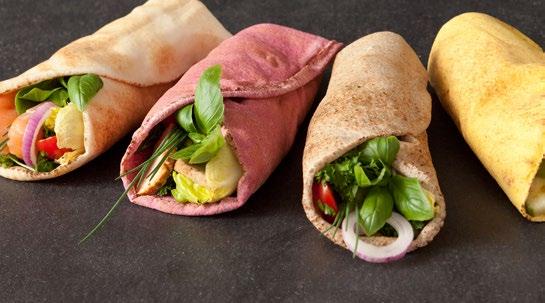
LIKA, LIKE AND SUBSCRIBE!
From its home base in Zaandam, Lika Bakery shows its excitement and skill in product innovation. Its new, award-winning creations are proof, joining an inviting product portfolio.
© Messe Stuttgart GmbH 42
PREPARED FOR THE FUTURE
Morten Riisager , Head of Business Unit Biscuit, Bühler Group, and Managing Director, Bühler Denmark, shared his thoughts about developing solutions for the production of biscuits.

COOKIES MAKE THE WORLD GO ROUND, EITHER WAY YOU MIX IT
Cookies speak the universal language of taking a moment for a delicious treat, anytime, anywhere. The stakes are high to produce the next favorite creation; but, technology provides different mixing methods to guarantee a perfect start.

FROM VISION TO REALITY: HOW AI IS RESHAPING PRODUCT INSPECTION Emerging machine learning applications take the guesswork out of quality control.
06 Part I – Plentz Bakery & Confectionery: One step ahead
10 Part II – Plentz Bakery & Confectionery: “Baker Plentz, they are one of us”
30 Lika Bakery: Lika, like and subscribe!
PIZZA, FLATBREAD LINES
14 Part I – AMF Bakery Systems: Naan, bread of the kings
18 Part II – Farhat: That’s a wrap! Lavash and pita, flatbread heroes
20 Part III – Rademaker: Pizza in any shape and form
22 backaldrin: Flatbread meets Aronia
60 Grainar: The rise of cricket flour vs the ‘yuck’ factor
CONVEYOR SYSTEMS, BELTS
24 Ashworth: Follow the blue, plastic road!
26 IPCO: A tight, steel belt on energy spending COOKIES
34 VMI: Cookies make the world go round, either way you mix it
TRADE SHOWS
36 südback: The future is now
40 Gulfood Manufacturing: Spotlight on game-changing technology
42 BÜHLER : Morten Riisager, Head of Business Unit Biscuit, Bühler Group, and Managing Director, Bühler Denmark: “Prepared for the future”
38 RONDO: (B)read all about it! Bread lines
50 Rademaker: Every pie season sparks joy
AUTOMATION, SOFTWARE, MONITORING
54 KPM Analytics: From Vision to reality: how AI is reshaping product inspection
64 FMCG Gurus: Dos and don'ts: functional ingredients
66 Business: The Bread Project
Food2Multimedia is a publishing house operating at an international level and specializing in researching and editing technical information for the baking sector.


baking+biscuit international
Our specialist journal concentrating on production professionals in large companies in the industrial and chain-store sectors. Published six times a year in the English language.
Our Review series provides in-depth analysis of clearly defined issues. This involves market analyses and is a comprehensive, informative presentation of the state of the art in process engineering. The f2m dictionary translates bakery terms into a mulitude of different languages.
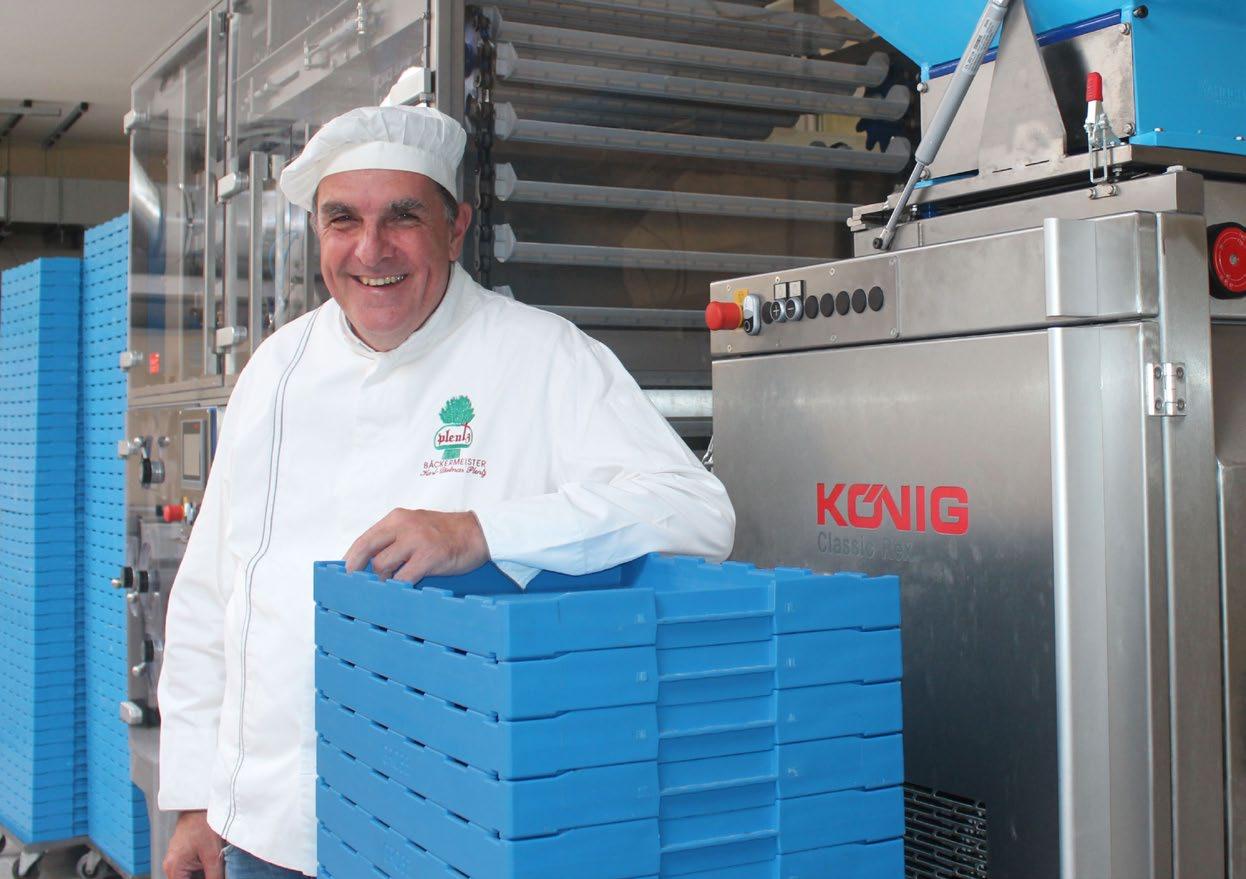
More went into the decision to purchase a new bread roll line than Plentz Bakery & Confectionery had expected. Several aspects were important, including the practiced social values of the company.
By Helga Baumfalk
+With nine branches and 170 employees, Plentz Bakery & Confectionery from Schwante in Brandenburg is not a huge company, but a powerful, healthy craft business, as bakery boss Karl-Dietmar Plentz himself puts it. When the old bread roll line reached its limits, a new one was needed. “And one that suited the size of our business and our requirements.” It had to be not too big, not too small. One that is flexible and compact at the same time, that doesn’t have to deliver exorbitant output, but that can produce up to 10,000 rolls per day, and one that leaves room for growth. Plentz: “When we looked into it, we soon realized how deep an issue it is. It’s not just about a machine, but about a process that includes new refrigeration technology and new processes.” It is definitely a pioneering investment. “You don’t buy bread roll lines in a hurry.”
During his market research, he came across many good solutions, but it was a visit to südback 2022 that pointed the way forward.
”Investing in a bread roll line is not just about a machine, but about a process that includes refrigeration technology and new processes.“
Karl-Dietmar Plentz, Managing Director of Plentz Bakery & Confectionery
“A line that suits us”
The new version of the Eco Twin, which bakery machine manufacturer Koenig was introducing in Stuttgart at the time, was not actually a favorite of the bakery boss. A visit to the Koenig stand changed this. “There was a stalemate between two solutions. That’s why I took the opportunity to see the Eco Twin live in operation at the social service provider Diakonie in Bielefeld. Together with our project manager, I stood in front of the machine one night and we noticed that the operator, a man with an

The bread roll line from Koenig is designed for artisan use. Almost all common types of bread rolls such as sliced rolls, Kaiser rolls, plaited rolls, etc. can be produced on it. For easy cleaning and maintenance, the line has been designed to ensure easy access to all modules.
Technical specifications:
+ Maximum hourly output (depending on the working width of the line): 4,200 to 6,120 pieces
+ Can be combined with various tools from the Koenig Rex series for 6-, 5- and 4-row operation with end position adjustment
+ Compact design: length: 3,770 mm, height: 2,525 mm
+ Working width: 800 mm, with direct depositing as standard for the production of dough pieces
+ Interchangeable cutting station with 3-, 4- or 5-pass guillotine; also available with 6-pass guillotine, at 800 mm working width
+ Automatic UV disinfection system for sterilizing the empty hangers before each refill
+ Adjustable depositing patterns via software, which ensures the exact positioning of the products on the most common proofing trays or baking trays
+ Dough pieces can be continuously adjusted in length and step; 800 mm working width equipped with pull-out tray as standard
+ Intuitive, freely programmable PLC control for cleaning and maintenance
+ Hangers and pressure cups can be easily removed from the system for cleaning
+ Smooth surfaces, including on the rear of the system, and large doors for viewing the production process and for better cleaning

for various punching and forming tools
apparent disability, was able to handle the technology. And that, I thought, was a very strong argument.”
In addition to the ease of operation, he was impressed by the uncomplicated changeovers and the line’s ease of cleaning. The fact that the after-sales service is guaranteed was also decisive, as was a balanced price/performance ratio. “In some details,” says the bakery boss, ”Koenig is one step ahead of others, in my opinion.” He cites the frameless doors as an example, which have the advantage that there are no corners that have to be laboriously cleaned.
Six days a week, for four to five hours early in the morning, the new bread roll line in the bakery in Schwante is now in operation. But, as the company’s owner believes, it isn’t running quite at the right time yet. “Because we want to be an attractive employer, our original aim was to bring production from the night into the day. We have not yet been able to flip this switch definitively, but we have at least created the technical prerequisites.”
One person is enough to operate the system. “We have given the main responsibility to a young employee who has

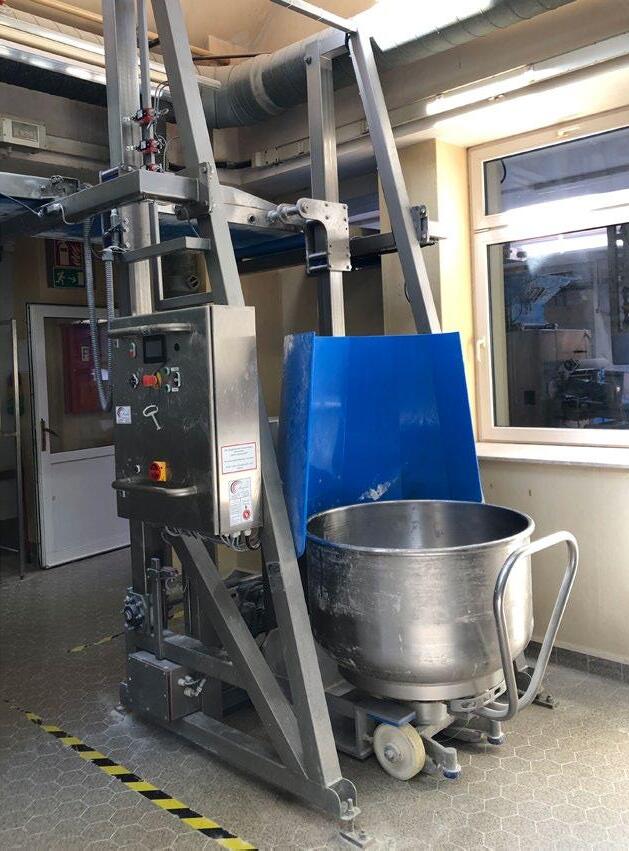
completed his training as a baker with us. The line is now his project. That in itself was very motivating.”
Before commissioning, the bakery was increased in size with a 200-square-meter extension in order to create space for the bread roll line, the handling of the peelboards, and 50 square meters of additional cooling space. A new lifting tipper was also installed. It now feeds both the bread roll line in the new building and a second dough-processing system in the existing building. This was “An important step to make our work easier,” says Plentz. Batch sizes were subsequently reduced and doughs and dough resting times were adapted to the new processes.
With more automation, consistency in dough quality is now more important. Dough temperatures are now documented and a recipe control system is being developed. “In the early days, there were quality fluctuations associated with the remaining dough. They caused a variability that could not be accounted for. But, everything has settled down now.”
The bakery uses the Eco Twin line to produce all its round and oblong small baked goods, while the ‘square range’ is produced on another, semi-automatic machine. The new line processes rolled, sliced, or stamped baked goods with three stamping tools, including around six types of wheat and seeded rolls, cheese rolls, dough pieces for crumble rolls and products locally called ‘pancakes’ (Berliners).
Roll production is now more efficient and profitable again. “We are currently establishing a purely machine-produced roll as an entry-level price product that is below the level of our hand-pressed rolls.” The hand-pressed rolls for EUR 0.50 are the absolute best-sellers in the range, explains the boss. The dough is produced with equipment, but shaped by hand.
Depositing the dough pieces is program-controlled and runs in five rows at Plentz. “Koenig provided us with an experienced specialist to put the setting patterns in place. The specialist came to the plant initially to provide training and a second time, a month later, to make a few adjustments. On a self-critical note, we should have defined the details more precisely: “What should be put on which support, how and where?” At this point, Plentz recommends that every baker considers exactly what they want, in great detail. This makes training easier.
After processing, the dough pieces are placed on peelboards, gently passed over a cooling curve – not frozen –and delivered to the stores by refrigerated truck. Sometimes they have to be re-cooked in the store. “Ideally, they are

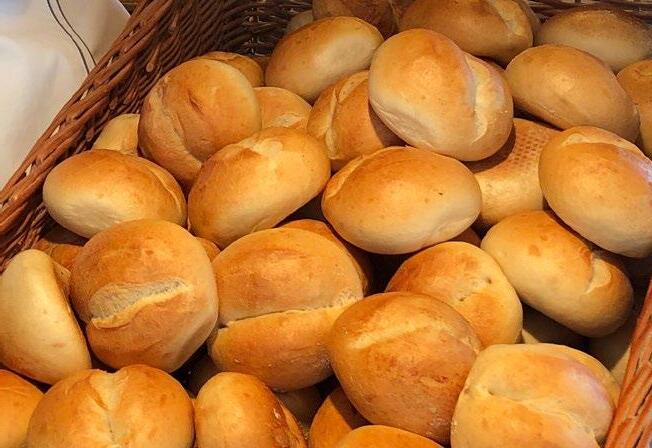
”Because we want to be an attractive employer, our original aim was to bring production from the night into the day. We have not yet been able to flip this switch definitively, but we have at least created the technical prerequisites.“
Karl-Dietmar Plentz, Managing Director of Plentz Bakery & Confectionery
three-quarter cooked and only need to be turned and heated a little before baking.” Baked goods that are sold in smaller quantities and are therefore only baked two or
ADVERTISEMENT
three days a week (such as raisin rolls, snails, or spelt bars) are placed in the freezer and selected as required for the next day.
For the future, Plentz is thinking about the automated production of a fava bean roll and how the potential of a special stamp – the Houski stamp, which the bakery is not yet using, can be exploited. Karl-Dietmar Plentz: “The stamp creates a plait pattern. You almost think the plait is real. A high product value can therefore be achieved with a manageable amount of effort. I can well imagine the stamp being used for a high-priced, seeded pastry, perhaps for a sesame plait.” +++


“Baker Plentz, they are one of us”
The Plentz bakery has been embracing regionality for years, long before the topic became trendy.
+“In 2002, we started growing our own grain, an old variety with the illustrious name, Champagne rye,” says Karl-Dietmar Plentz, not hiding the challenges. “You have to be a bit patient. In 2023, we were worried whether we would even have enough baking capacity.” The bakery also uses locally sourced blueberries, strawberries and eggs and, because it tells its customers about its valued regional partnerships, the concept also works. “Alternatively,” he says, ”For the sake of complete transparency, no bakery can function purely regionally.” After all, no sesame seeds are grown in Brandenburg.
The bakery uses convenience where it is needed and buys in the odds and ends. They are open about this. Plentz: “In return, we fully showcase our passion for craftsmanship in our own baked goods and strive to bake products that are not comparable, such as the field bean bread or our wood-fired breads. That is our strategy.”
The wood-fired oven baking days
Fridays and Saturdays are wood-fired baking days. Farmhouse breads, herb breads and crumble cakes are baked in the brick-built wood-fired oven opposite the main store. The offer is popular and even attracts customers from Berlin, around 25 km away, to make the trip to Brandenburg. Many like to stock up and take two or three more loaves home. “People buy for the feeling, not to be full,” Plentz is certain. Bread and rolls each account for around 30 % of sales. In the sweet segment, pastries such as snails are less in demand,

”With our own baked goods, we fully showcase our passion for the trade and strive to bake products that are not comparable.“
Karl-Dietmar Plentz, Managing Director of Plentz Bakery & Confectionery
but sheet cakes (22 varieties) and Berliners – which are sold all year round – are all the more popular. In the last quarter of the year, handmade dominoes topped the sales rankings. Snacks are a growth market (12.5% share of sales).
The bakery sells most of its products through nine of its own stores. All of them are high-turnover locations with a focus on bakery stores and an adjoining café. As much as 5% of




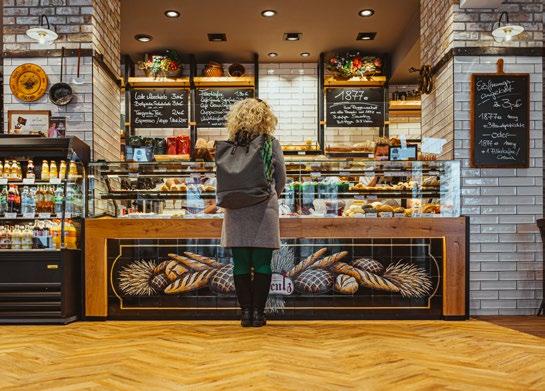

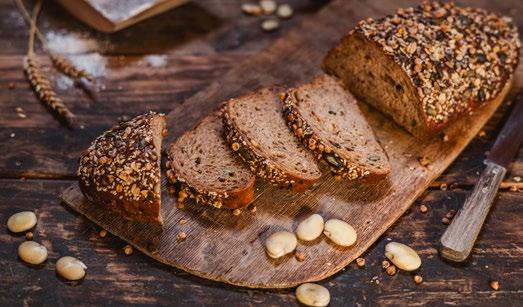

revenue comes from the online business, which only does really well in the last few months of the year. A marginal share comes from the delivery business.
The company works for and in its community. This is expressed, among other things, in literal interaction with customers. “In the places where we are represented, we live with the people.” Plentz explains: “We have our door open when the fire department calls and asks for a discount on the bread rolls for the fire department festival. We organize oven or harvest festivals, donate to soccer clubs, work with cultural groups, choirs, or allotment associations.” He also knows: “Bakery cafés like the ones we run are sometimes the last meeting place that still works in rural areas. Young mothers meet in our cafés to exchange ideas, and there are regulars' tables for postal workers or entrepreneurs. We really encourage these encounters.” The company boss sees the proximity to customers as one of the greatest strengths of his business. “We like to be hosts, it is in our DNA. And customers know that: Baker Plentz, they’re one of us.”
Closeness is also practiced among the team of 170 employees. No wonder staff turnover has not been an issue so far. However, as is the case everywhere, there is now a slight outflow of staff. As far as trainees are concerned, Karl-Dietmar Plentz has nothing to worry about. “We have more suitable applicants than vacancies.” The company is also well-positioned in production. The challenge lies in sales due to a high sickness rate.
The company boss sees the added value of the newly created position of personnel developer. “He trains our junior managers and team leaders, coaches on tasks such as, 'How do you criticize without hurting?' or, 'How do you prepare the annual evaluations?' He helps me as a mediator when friction arises among employees and he accompanies our company handover process.”
The bakery remains in the family's hands. Karl-Dietmar Plentz still holds the majority of the shares. He is gradually handing over responsibility to his daughter Emelie Albe (authorized signatory and responsible for sales), son-in-law Ralph Keidel (Commercial Director) and son-in-law and master baker Maximilian Schöppner (Head of Production). His sons, Alexander and Max Plentz, also work for the company, as the marketing team leader and a baker, respectively.
The branches are open six days a week, but never on Sundays. “I know for a fact that we would do good business on Sundays. Nevertheless, my wife and I decided from the very beginning that Sundays are for the family. We follow the old Christian rule. In terms of employees, this is to our advantage because it makes us attractive to applicants from the restaurant business. We have a lot of good salespeople who come from the restaurant business. They don’t see the customer as a customer, but as a guest. There is a big difference in that.” However, Karl-Dietmar Plentz emphasizes: ”I don’t disapprove of anyone who works seven days a week. But we have chosen this path.” +++
American Pan understands the importance of finding the right pan for your bakery’s unique products and needs. Our team of experts can design an innovative solution tailored for your bakery, offering a variety of materials and pan strengthening features, as well as:
• Sizes & Arrangements: Customize your overall pan size, cavity arrangements, and dimensions.
• Cavity Designs: Choose a standard muffin or cake cavity or create a unique design for signature products.
• Coatings: Select one of our world-class, proprietary coatings, designed to aid in the easy release of a variety of dough formulas.

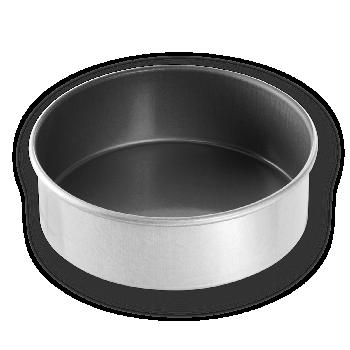
Want to prolong the life of your bakeware? Your pans can be cleaned, recoated, and returned to your operation like-new with our bakeware refurbishment services.



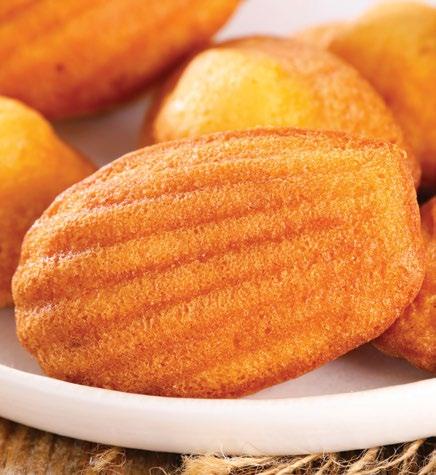


Laborious leavening and skill scarcity made naan bread a nutritious yet elusive delicacy for centuries, first reserved for India’s royalties and nobility. As flatbreads grew to become a valued staple worldwide, technology has provided answers to all its production challenges, to match traditional handcrafting techniques.
+Naan bread is made with flour, water, salt and yeast, to which other ingredients are sometimes added, such as oil or butter. Yeast is traditionally used, but it can also be made without it. A lot has changed since the first historical recording of naan bread, around 1300. It was first cooked in Dehli’s Imperial Court. Mentions of it were found some 200 years later, when it was still reserved for the menus of royalties, because of challenging leavening techniques, and ingredient scarcity. In the 2000s, naan now belongs to everyone; the bread is enjoyed as a side to flavorful dishes, everywhere in the world – in ethnic restaurants, and it has its own established seat in supermarket aisles, too.
Technology was developed to replicate the qualities of the naan bread made in the traditional tandoor, clay ovens. AMF Bakery Systems has developed equipment lines that fully automate the production of naan and other flatbread specialties, baked with traditional ingredients but upscaled to higher production volumes. With these lines, naan breads can be cut into the traditional teardrop shape and baked on a Den Boer brick tunnel oven, all of which contribute to the bread preserving its traditional feeling.
The technology allows for endless arrays of product variations, either leaning toward more typically industrial products, or focusing on enhancing a traditional, artisan look and feel. “The product category of flatbreads, naan and pita is very wide, and we have tested many at our AMF Innovation Center. Variations in thickness, diameter, with inclusions in the dough or without, with decorative toppings such as
herbs and spices, different baking times, and proofing times – changes in all these factors will result in a different end product, so the possibilities are literally endless! This is why we invite everybody to visit the Center for a demo or test run,” in the Netherlands, the specialist highlights.
Given their diversity, naan and flatbreads can be made in various ways, to achieve the best results for unique specialties and in different environments.
”Saving on gas and electricity, using less compressed air, and conducting life cycle analyses for each AMF machine is our goal, in order to know and manage the complete life cycle, and to report about it.“
AMF Bakery Systems specialists
A dough sheeting line can be incorporated, where products are cut from a dough sheet, proofed and then baked at high temperatures, for a short time. To form the sheet, the mixed dough is cut into chunks of the same size and weight. These pieces are then formed into an endless sheet of dough using several roller and multi-roller systems in the Tromp sheeting line. When the desired thickness of the sheet has been reached, a continuous cutter cuts out the shape of the pita, naan, or flatbread. The leftover dough is separated by the sheeting line, to be reused in the mixer
or elsewhere in the process. Depending on the recipe and process, it can be reintroduced in the mixer, together with the fresh dough.
Another dough-forming method with its corresponding technology is working with dough balls: the dough is created with AMF extruders, and the resulting dough balls are either pressed or rolled out into a thin piece of dough. The product then follows a similar route as those created with a sheeting line, proofing, and quick baking at high temperatures. Baking can be done in a tunnel oven – on a stone or mesh belt, depending on the style of the flatbread.
To select the adequate technology for the product, “It all starts with the recipe and the final look, structure, crispness and the intended aspect of the product, artisan-style or not. When these characteristics are defined, the
best solution and make-up process can be determined. In general, most products can be sheeted using a low-stress dough sheeting line by Tromp,” AMF’s specialists explain.












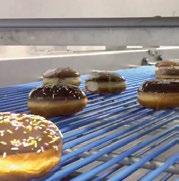






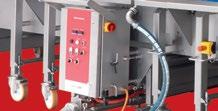











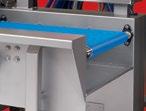








some steps contributes significantly to efficiency. “A robot never gets tired or needs a break, for example; these extra hours of production or increased speed can be great improvements in the process,” the specialist observes. In choosing the best-suitable equipment lineup, the final product/recipe is always the first aspect to consider, to which capacity, ingredients, production hours/staff, future plans and flexibility are also added, among factors influencing the selection. “Capacity and throughput are always scalable in our design philosophy. But the specific shape of a product, a specific proofing, baking, or decorating process, means tailored solutions to design a line like this. In most cases, this is solved by using standard technology and machines, sometimes tailored to a specific need. And always by integrating in existing situations, for fluent flow and process control,” AMF explains.
Consistency is key in industrial baking. The AMF sheeting lines and extruders reliably ensure consistent results and are built for 24/7 use, if required. For mixing, horizontal batch mixers can be selected, or continuous mixers for higher production volumes. “Sheeting lines are configured to current volumes and future growth projections, while proofers and ovens can also handle high capacities, in a stable, climatized environment,” the specialist says.
The line’s capacity and volumes produced will determine the production speed, as well as resting times and baking times: “These factors are all calculated, engineered and built accordingly for our customers, “ AMF highlights. The process delivers consistency in results: with stable factors
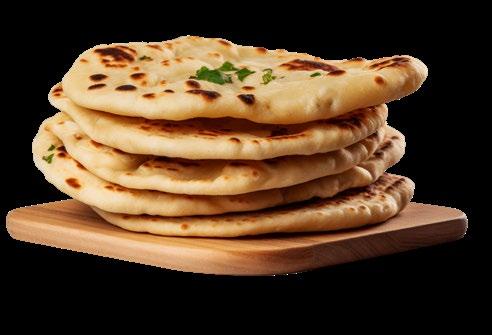
such as temperatures, dough quality, energy, hygiene, and people, an AMF production line ensures stable results.
Service and maintenance support also contribute to increased productivity and are provided. Lines covering the entire production process are designed and engineered, turnkey solutions starting from mixing up to packaging and post-packaging.
“Lines are mostly tailored to customer needs and have the flexibility to include additional pieces of equipment later, e.g., equipment units on c-frames that can be used for depositing and be removed when changing to other products. Upgrades to more automation, more capacity, less operator intervention are all possible in later stages,” the specialist illustrates. One line can be dedicated to a single type of product with variations in sizes and shape, but it can also be designed for entire product families, according to the bakery’s needs. AMF TROMP and Den Boer turnkey lines allow wide variations for flexibility.
The naan and flatbread line receives regular technology upgrades. For instance, AMF has recently revised the concept of its sheeting and extrusion lines, adding new features.
In addition, smart, AI solutions are now available for toppings, and its Sustainable Oven Service can be used for better oven performance and lower gas consumption. “Saving on gas and electricity, using less compressed air, and conducting life cycle analyses for each AMF machine is our goal, in order to know and manage the complete life cycle, and to report about it. This also helps with raw material savings/recycling,” AMF underlines. The line now has a more hygienic design so it can be washed down easily and prevent health hazards and contamination risks.
To develop new technology concepts, the R&D team follows customer feedback and market trends and new developments around naan and flatbreads. For example, smart AI-driven solutions are now part of the manufacturer’s digital strategy. AMF also sees sustainable solutions as an absolute must for any future developments. +++






Our plastic belts offer excellent airflow, optimum product support, a unique load sharing design for improved strength, and an easy to clean link rod interface.
Metal belts allow the end user optimal production possibilities, while ensuring strength and durability for the most demanding applications.
There is nothing average about these flatbread heroes: lavash and pita each bring powerful personalities to diverse culinary creations. Wraps alone offer a world of eating experiences, and consumers are eagerly taking note. Under such promising circumstances, only one question remains: how to optimize production with consistent, quality results?

+To best describe lavash with just one word, ‘versatility’ would be a first choice. This thin, soft flatbread owes its texture to the fine flour it uses, and its soft consistency to the production technique. In this way, it becomes a canvas for exciting creations, from wraps to quesadillas, and is also enjoyed as a standalone side snack. By comparison, pita is made for a different approach to eating, as it is often used for pocket-shaped creations, and is a popular choice for falafel and gyros sandwiches.
Beirut, Lebanon-based Farhat Bakery Equipment recently upgraded their production lines so that they can produce both. The company founded by Mahmoud Farhat, a pita baker, some 50 years ago, combines traditional techniques with latest-generation technology for its flatbread production lines. Replicating flatbreads’ handmade, artisan quality through automated production is a critical challenge in industrial baking. Modern continuous sheeting lines developed by Farhat achieve this through strict process control: “Automated lines can closely replicate the traditional kneading, resting, and baking processes by precisely controlling temperature, humidity, and timing,” the specialist explains. In this way, the resulting breads have the same texture and flavor as artisan products. Automating the processes, in turn, ensures consistent product quality, which is a challenge in artisanal production due to frequent variations. “Advanced control systems ensure that each flatbread maintains the same texture, taste, and appearance,” at the same time, says Farhat.
Much like the lavash and pita products, the lines are versatile to accommodate recipe diversity and various baking techniques, so they can meet production requirements for
”The latest generation of machinery ensures exceptional accuracy, allowing for consistent dough sheet thickness, even for the thinnest flatbreads.“
Farhat Bakery Equipment specialists
bakeries and culinary cultures anywhere in the world. Farhat’s lavash and pita production lines streamline processes to improve baking operations. Automation features reduce manual work required, as well as production times. The lines are designed to ensure consistent quality and focus on accuracy and speed for high-volume production. Ease of use and maintenance were also considered in their design: “The automation control systems are intuitive, allowing operators to select from a list, or introduce new recipes quickly,” Farhat’s specialists explain.
Consistent quality pita and, by extension, any flatbread specialty, relies on the characteristics of the dough. To ensure the dough stays within set parameters, Farhat incorporates continuous sheeting systems into its lines. The sheeting process involves rolling out the dough into flat sheets of uniform thickness: the dough is first calibrated, as it passes through a series of rollers, to achieve the desired thickness, and then cut into the required shapes – whether circular, square, or custom geometries, before moving to the proofing and baking stages, where the shaped dough is baked with the advanced infrared tunnel oven.
This controlled sheeting process ensures thickness consistency, which is crucial for flatbreads like pita, which require a

specific texture and pocket structure. For industrial production, the improvements that continuous sheeting production brought are nothing short of revolutionary in flatbread manufacturing, the Lebanese specialists observe. Its continuous sheeting lines provide several advantages:
+ Flexibility in production: the lines can produce a wide variety of flatbreads, including pita, lavash, naan, Cypriot pita, souvlaki bread, and other traditional flatbreads in various sizes, shapes, and thicknesses. The fully customizable lines can process a wide variety of products, matching individual needs – flatbreads and other bakery products. They are commonly used to produce a wide range of flatbread types, including pita, naan, lavash, and other traditional flatbreads.
+ Fast changeovers: the line can also be modified to produce different specialties by swapping the rotary cutter. “One of the standout features of Farhat Bakery Equipment's Continuous Sheeting Line is its adaptability, which allows bakeries to quickly shift between different shapes and product sizes without extensive downtime, making the production process more versatile and efficient,” the specialist highlights.
+ Volume production: the system's capacity to handle large production volumes makes it ideal for medium to industrialscale operations, Farhat highlights: “Production can reach 3,500 kg dough per hour, ensuring consistent output without compromising quality.”
+ Consistency and exact shapes: automated controls ensure that each bread maintains the exact geometry and uniform thickness, which is particularly useful for delicate flatbreads where thickness can be as low as 0.6 mm.
+ Customizable shapes: the machines can be adapted to produce flatbreads of virtually any geometrical shape, for unlimited product variety.
The design of Farhat’s newest continuous sheeting lines incorporates the latest technological advancements: they
are fully automated, covering all processes from dough preparation to extrusion, calibration, cutting, proofing, and baking, through to cooling, stacking, and packaging. “Each production stage, including dough brushing and dusting, is seamlessly integrated,” Farhat specialists underline. In addition, by having all the components designed and manufactured within the same engineering department and factory, ensures a seamless production flow. Also, each machine is perfectly compatible with its ecosystem. Moreover, the processes are minutely controlled on the line, for enhanced productivity and quality assurance. And last but not least, “The latest generation of machinery ensures exceptional accuracy, allowing for consistent dough sheet thickness, even for the thinnest flatbreads,” Farhat’s specialists highlight.
In line with modern technology concepts, Farhat’s continuous sheeting lines are modular, allowing easy integration of new products on existing lines: new flatbread products can be added by simply switching or adding minor units to the existing setup. “The flexibility extends beyond flatbreads to other bakery items, such as pizza bases or Greek pita, with minimal adjustments,” the company highlights.
The modular design also means the lines can easily be expanded and updated with new technology improvements, which may include new features such as enhanced control systems, faster changeovers, or additional product handling units.
With energy efficiency topping all priority lists, anywhere in the world, Farhat made savings central to the design of the lines: “All components, from motors to burners, are selected for optimal performance and energy efficiency. The lines are equipped with the latest-generation technology from high-end suppliers focused on energy-saving solutions.” They come complete with an efficient infrared tunnel oven, with high-performance burners and insulation to minimize energy consumption and reduce heat loss.
The growing appetite for ethnic and traditional flatbreads, from lavash to pita and including any flavorful interpretations, gives wings to promising baking business, with plenty of technology innovation to support it. +++
Ever the safe-choice favorite, but never a boring idea: pizza enjoys great diversity, to match all tastes, eating occasions, and curiosity for new taste experiences. A steadily growing appetite for pizza is met with interesting new offerings, including plant-based, premium, and limited-edition launches. Technology meeting these trends is a must for efficient pizza baking.

+Pizza launches have seen a 2% growth over the past four years, driven by innovations in dough fermentation techniques and diverse baking methods like stone, wood, and convection ovens 1
Europe is home to the most new product launches and reigns in pizza sales worldwide. This is where limited editions, unexpected flavors and premium creations thrive. New products include diverse varieties of cheese, chargrilled vegetables and smoked ingredients, Innova Market Insights research shows. This is not to say pizza’s popularity is dimmed elsewhere: the fastest growth in sales value has been recorded in the Asia-Pacific region for the past two years in a row. Here, new product development favors seafood-topped pizzas, combinations of cheese with vegetables, and mushroom and meat toppings 2
Health and flavor rule the product positioning trends. In September this year, Innova ranked the top five positionings in the pizza market worldwide, as follows: no additives or preservatives, vegetarian, traditional, source of protein, and gluten-free. In addition to these, GMO-free, no trans fats, halal and plant-based are other notable claims gaining ground for pizza.
Pizza comes in all shapes and sizes, each with its own recipe, ingredients and process steps, now with more diversity than ever. Automated manufacturing, especially large-scale, is far from easy to capture in one process, Rademkaker explains: “From pan pizza to classic varieties and Neopolitan styles, understanding each process is key to creating the best pizza
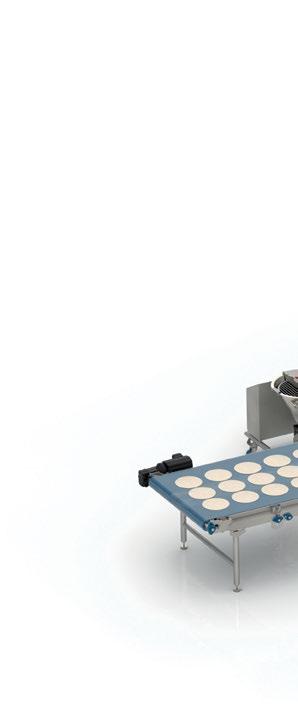

on the market.” Rademaker helps customers finetune and perfect their recipes and processes at its Test Centre, supporting the wide range in pizza processes. Products can range from thin and crispy pizza to fluffy and airy bases, folded edges, and stuffed crusts, for example.
”We have also upgraded certain dough sheeting units in our production lines so that the dough quality and consistency are improved. We are excited about these new technology features and will be introducing the new equipment at iba 2025.“
Wouter van der Veek, Product Manager, Rademaker
The company has a strategy dedicated to improving its pizza manufacturing equipment. Within this program, “Continuous research and development is carried out toward improving the efficiency and profitability of the Rademaker production lines,” Wouter van der Veek outlines. This includes focusing on the continuous improvement of weighing the products, to help pizza manufacturers reduce the giveaway of expensive topping ingredients.
Some of the latest R&D efforts focused on the production of the dough sheet: Rademaker brought new improvements to its pre-sheeter, which can now handle very liquid, pre-fermented soft and airy dough batches and transforms them into a consistent dough sheet, the company highlights. The sheeter contributes to the production of premium, artisan-

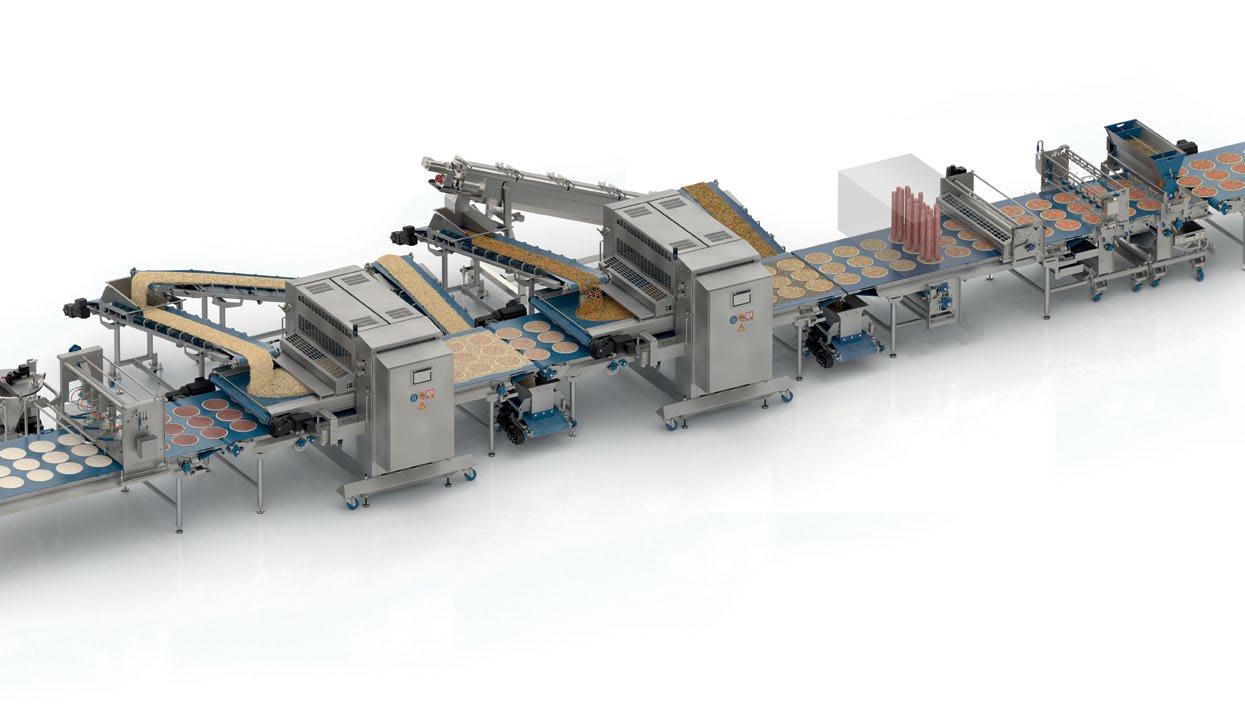
looking pizza and pinsa product ranges. More improvements are on the way, in addition to these developments: “We have also upgraded some of the dough sheeting units in our production lines so that the dough quality and consistency are improved. We are excited about these new technology features and we will introduce the new equipment at iba 2025,” Rademaker anticipates. The equipment going into Rademaker pizza topping systems has also been revised and upgraded, and a new topping line will also be showcased at iba in Dusseldorf, in May next year.
Also new in Rademaker’s pizza solution roster are new techniques to make stuffed crust and folded pizza edges, available through its partnership with Form & Frys Maskinteknik – a Danish company specializing in folding, forming, and filling machinery pastries and baked goods. In 2023, this agreement established Rademaker as the exclusive representative of Form & Frys solutions in several European countries, including Austria, France, Germany, Ireland, Switzerland, and the UK, as well as across the North American continent. “This equipment can be integrated into the Rademaker lines and serve as an alternative solution, building on the existing knowledge Rademaker has of this specific process,” van der Veek explains, adding that “The development of new equipment is a co-operation between our Pizza Product Group, the R&D department and our customers.”
New equipment is designed for integration into new and existing lines, too. Pizza topping equipment for ingredient depositing and cheese application, for example, is easily retrofitted and comes with standalone control systems.
Resource optimization is always a must-have, regarding energy as well as raw materials – which often come with a high price tag, especially when baking the now-trendy premium and limited edition pizzas. When used as toppings for pizza, cheese and proteins can be particularly expensive ingredients, making up the bulk of the costs for an end product. “Recirculating these ingredients when applying
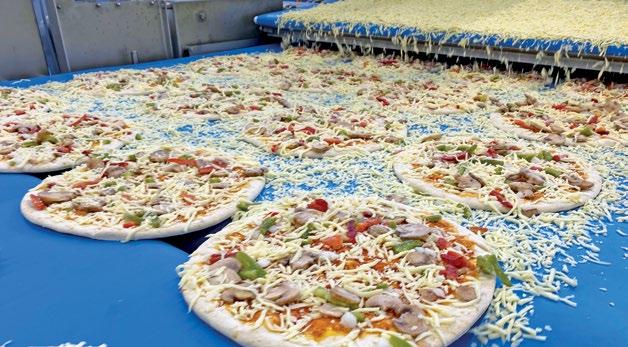
them ensures nothing is lost,” Rademaker highlights. The process prioritizes maintaining the optimal ingredient flow through this loop, with little to no spillage in the first place. High accuracy in depositing ingredients on each pizza makes this possible, as it prevents waste and the over-application of these ingredients, which would result in giveaways.
Moreover, Rademaker’s sheeting lines come with dough recycling systems that return valuable ingredients making up the pizza base back into the mixers or at the front of the line, where they re-enter the dough production process. “Trials at the Rademaker Technology Centre ensure that specific customer recipes are finetuned to support this,” the Product Manager explains how the process is optimized.
Processing efficiency is at the top of the list, but not the only requirement for automated pizza lines. The flexibility to produce diverse specialties is an equally important priority. A latest-generation line can be customized to meet any production plans and specific markets. Rademaker specialists observe: “Daily fresh production has different market requirements than deep-frozen topped pizza for home baking. We think it is important to constantly look at market developments and trends.” Production equipment that can adapt to any number of developments and trends – and do so while maintaining process efficiency and high product quality – is key to making strides and creating tasty pizzas, either fresh or frozen. +++
The flavorful landscape of flatbreads is rich with choices for a wide range of products in unusual, creative interpretations. Aronia brings a new flavor and color inspiration.

+Aronia is known as an ornamental plant. Its sour berries, called chokeberries, can also be eaten –fresh, or made into jams, juices, syrup and wine. A new ingredient developed by Austrian specialist backaldrin International and launched this spring brings a fresh addition to the ever-versatile flatbread recipes: chokeberry flavor. While the fruit gets its name from its astringent flavor that might make some mouths pucker, Aronia-tasting flatbread promises a mouth-watering experience, with an exciting, vibrant purple hue. What’s more, Aronia’s fruit provides a wealth of secondary plant substances, such as anthocyanins – antioxidants known to have many health benefits, including anti-inflammatory activity. An established power fruit, the chokeberry confidently enters the scene of flatbread creations.
The AroniaMix developed by backaldrin proposes a visual and taste novelty in the production of flatbreads. It brings spectacular shades of purple to the crumb of assortments, thanks to the anthocyanins in the Aronia fruit. The mix consists of dried, crushed chokeberry pomace, fine aromatic wheat sourdough and apple juice powder. The key ingredient is the star of the show: the Aronia pomace. It is obtained during juice production and then gently dried. “The antioxidant substances found directly under the skin of the Aronia berries and in the seeds were a determining factor in the composition of our mix,” backaldrin underlines. It is a clean-label product, containing no additives and no E-numbers. In keeping the product clean label, it was a must to use only easy-to-recognize ingredients and no artificial ingredients. For example, “The mix also contains apple juice powder, which adds a subtle sweetness to baked goods,” the specialists describe. The Aronia pomace gives baked goods a mildly fruity, pleasantly sour taste, while the notes of apple juice and the mild aromas of wheat sourdough gently round off the bouquet.
To perfect the AroniaMix, backaldrin used inspiration from the variety of colors in nature. “We wanted to develop a clean-label product with an appealing color and taste. In addition, we were looking for ingredients that have not been widely used in bakery or patisserie and that can have health benefits,” backaldrin reveals about the new development that marks its 60th anniversary, this year.
To enjoy its benefits, the Aronia Mix should simply be added to the flatbread recipe. “For optimal taste and color, we recommend a dosage of 20%,” backaldrin suggests. The baked flatbreads can be sold ‘as is’, or can be further personalized with any variety of fillings to create delicious snacks.
In addition to flatbreads, the AroniaMix is versatile to allow use in any type of bread recipe, including fine yeast dough recipes, and even patisserie products such as muffins. Recognizing the growing popularity of flatbreads in Europe, backaldrin also created a recipe folder, which includes suggestions and snack inspiration. Unique flatbread ideas include, but are not limited to Aronia, chickpea, rapeseed, or purple wheat. +++


Our solid and perforated steel belts have helped bakeries produce premium quality products for almost 100 years.
Flat, straight, durable and easy to clean, they provide a baking surface that’s ideal for everything from rich, chewy all butter cookies to traditional biscuits and crackers.
We can also support you with a wide range of conveyor components covering everything from tensioning, drive stations and drums to tracking systems, break points and graphite stations. Talk to your local IPCO service team and we’ll work with you to improve the performance, productivity and reliability of your oven through process enhancement and system upgrades.
High productivity wide belts up to 3500 mm.
Maximum versatility – bake more on an IPCO steel belt.
Energy efficient – lighter belt means lower carbon footprint.
High power laser cleaningfaster, cleaner and greener than traditional cleaning.
Installations, upgrades (mesh replacement), repair, maintenance and spare parts.

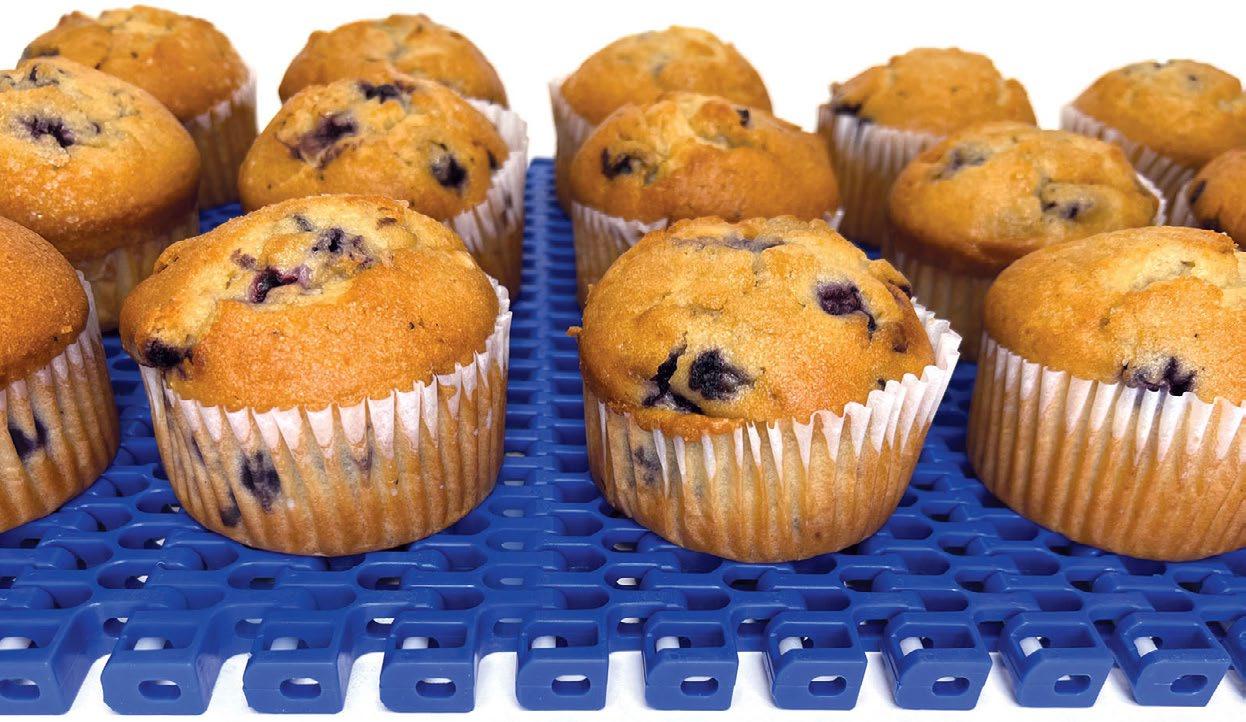
Plastic conveyor belts bring unique characteristics to the table - they are light, hygienic and easy to fix. In bakeries, plastic belt systems can be configured for several operations, as they provide a great solution to driving the products through processing steps.
+Just like their metal counterparts, plastic belts can be customized to meet specific requirements for several processes in a bakery, including cooling, proofing, and freezer applications. They can be successfully used for smaller products, too, and can perform tight transfers. Why plastic? “Plastic offers release properties that metal may not allow. Plastic belts can also run quieter and can often be repaired quicker and with simpler tools than metal belts,” explains Jonathan Lasecki, Ashworth’s Director of Engineering. Their smooth surface lends it to minimal product sticking, as does the reduced contact area.
”Plastic offers release properties that metal may not allow. Plastic belts can also run quieter and can often be repaired quicker and with simpler tools than metal belts.“
Jonathan Lasecki, Director of Engineering, Ashworth
Ashworth’s plastic belts, for example, are tested for over 100,000 fatigue cycles, under all the conditions needed for cooling, proofing and freezing in a bakery. They are designed for use in spiral systems predominantly, but can also be used in other conveyor segments. Possible configurations can be flexibly designed: “These belts will operate on both inclining and declining systems and all typical belt paths, straight through, 90-degree, etc. They can also be used on straight running and turn-curve conveyors,” Lasecki details. Both belt models made by the American specialist,
SpiralSurf ® 100 and SpiralSurf® 200 (with 1” and 2” pitch –the distance between rods), can be used in bakeries, and are particularly well suited for conveying baked or packaged products. They come in one surface style (as pictured), designed with openings and patterns that can accommodate various products. Plastic belt systems can have multiple uses. But, sticky products such as raw dough should not be placed directly on the belt for freezing, the manufacturer notes, as they have more strict conveying requirements when being conveyed, on any type of surface.
Ashworth SpiralSurf ® belts are manufactured with either Acetal (POM) or Polypropylene (PP) components. The first option, POM, is suitable for use between -40°C and 93°C (-40°F to +200°F), while PP should be used for processes running at temperatures in the 5°C to 104°C range (+41°F up to +220°F). To customize the belts, plastic or stainless steel rods are available. For products that may move on the belt, guard edges are an optional feature that can be requested. For product sorting, lane dividers are also available.
Assembly is another benefit of plastic belts. Setting up Ashworth’s SpiralSurf ® belts is simple and requires no special tools: “Connect the ends and insert a connecting rod to make it continuous. General construction rules used for belt conveyors apply,” Lasecki explains, adding that suitable guarding should be installed for personnel safety. As long as the conveyor is correctly set up, the belt will track and run as intended: “A proper take-up system must be part of the conveyor construction, to allow for variations in
belt length due to tension, wear and/or temperature variations,” the specialist observes. The SpiralSurf ® 100 has smaller open areas to support smaller products safely, while the SpiralSurf® 200, which has larger open areas, allows for better airflow.
While lifespan may vary according to utilization, Ashworth belts are guaranteed to run for well over 100,000 cycles, where a fatigue cycle is a load/unload of tension in the belt. As a general consideration, the operating speed influences the belt’s longevity: a belt running slow will last much longer than a belt running at fast speeds. In general, belts should run at maximum speeds of 30 m/min (100 ft/min); however, some processes require belts to run at considerably higher speeds. In this case, a corresponding shorter lifespan should be expected, as well as more frequent service/maintenance work throughout.
Cleanliness is also critical to extending the plastic belt’s life. “Allowing product debris or fine dust particles to accumulate on the belt will create abrasive wear and lead to belt stretch and/or component failure,” the specialist underlines. Ashworth recommends what to consider to extend their lifespan: “Plastic belting is affected by harsh cleaners, UV light and the lack of or improper monitoring of the belts’ operation. Plastic belts will typically break either at the hinge rods or the belting modules themselves,” he adds.
One of the advantages of plastic belts is that only the damaged section can be replaced, by removing a pin ahead and just after the damaged section, and then adding a new section that matches the previous one in length. The old part is sent off to recycling, while the new part is installed by joining the ends and inserting the necessary connecting pins.
In day-to-day operations, the belt must always remain perfectly aligned and its tension must be uniform across its width. Misalignment of only a few mm can lead to belt damage; uneven tension leads to mistracking and causes the belt to stretch and break over time, causing downtimes unless prevented. Belts should be inspected frequently (relative to the process), to avoid this, Ashworth recommends. “Inspection checklists must be established at each installation, based on the system and process parameters,” Lasecki underlines. System alignment is critical to proper belt operation.
Setting up a production line with plastic spirals (or other suitable conveyors) is not only a choice helping with process efficiency, but also proof that there are still applications where plastic is a great choice. +++









Spending energy with the utmost caution is not a present-day, circumstantial trend. For bakeries, it is a hard reality and will only continue to become more important going forward. Energy savings and sustainability improvements start in the oven.
+A complex set of factors and metrics encompass sustainability in bakeries. There is no fixed algorithm to work with, either, as there is a different set of variables that characterize every bakery. There are several ways to assess – and then improve – the sustainability of an operation. Environmental impact is among them, which includes managing carbon footprint and energy consumption.
For baking ovens, the characteristics of the steel belts are one aspect to consider when looking for sustainability improvements. Equally important, however, is to look at the big picture over time and consider the lifetime of the belt. Both solid and perforated steel belts have a considerably longer lifespan, compared to other types of belts. Their working life is typically 20 years or more, often much longer. Steel belts twice this age can still be in operation and perform well. “They are less susceptible to damage, be it through impact, wear and tear, stretching or deformation,” IPCO underlines. This extended timeframe significantly factors in the overall return on investment.
Energy savings when baking depend on numerous factors, including (but not limited to) the design of the oven itself, the product being baked, and the parameters of the baking process. There are other factors to be taken into account in analyzing the efficiency of the baking process, including the energy used in heating the belt throughout the baking process, and in actually moving it through the oven.
Steel belts are lighter than wire mesh so less energy is needed to heat them to the required temperature. “Each time the belt exits the baking chamber, it begins to cool and has to be heated up again. We estimate potential energy savings to be in the region of 30 % for solid steel belts and even more for perforated. Given that as much as
25% of an oven’s energy consumption goes into heating the belt, the savings can be considerable,” IPCO’s specialists calculate. The lighter weight not only benefits the energy spent in baking, but also means less power is needed to ‘drive’ the belt through the oven.

”The laser is installed above the belt and the beam is focused on an area approximately 75 mm wide. As the belt travels under the laser, carbon deposits are burned off and collected by a vacuum system.“
Marko Leber, Global Product Manager, IPCO
Various perforation designs make steel belts even lighter than solid ones – good news for the energy needed and for the baking process, too. IPCO perforated belts are available in five standard perforation patterns, with circular
hole diameters ranging from 2.0-5.5 mm. Each pattern determines the amount of air that can pass through the belt, allowing different rates of air circulation within the oven. “Tests can be made to determine the optimum perforation for the type of product being baked,” IPCO explains. In most cases, one of the standard patterns will be a suitable choice. If not, custom perforations can be engineered for specific requirements, with hole diameters as small as 0.8 mm, if needed.
Determining the exact parameters of the steel belt goes a long way to efficient baking, for a long time. The design of the oven itself and the product portfolio will dictate the best-suitable choice. The type of product being baked is very often the determining factor: “Certain goods – real butter cookies for instance, or chocolate brownies – need the flat, solid surface of a steel belt. Otherwise, the fat would melt into the oven, with the resulting risk of starting a fire. A solid steel belt will also usually be the preferred choice for products such as biscuits, pastries, shortbread and granola bars. Alternatively, perforated steel belts can be a ‘best of both worlds’ option, opening up the possibility of producing both ‘mesh’ and ‘solid belt’ products on the same line,” the baking oven belt specialist illustrates.
Another important aspect, when looking at the operating cost throughout its lifetime and the environmental impact of a product, is the repairing process. This is especially relevant for steel belts, given their extended lifespan. This is where they shine, given their durability and ease of fixing: “Small areas of damage can be patched and larger areas cut out and replaced. Hairline cracks caused by fatigue can be welded, and edge burrs can be filed back,” the specialist details. If a belt is showing signs of deformation, it can be straightened to its previous flat surface, with equipment such as IPCO’s Shotpeener Pro repair tool. “This is a portable unit that is used to blast steel balls at high pressure across the width of a belt as it turns around the terminal drum. This equalizes stresses on both sides of the belt to remove deformations,” its manufacturer explains.
However, steel belts are extraordinarily durable pieces of equipment, so any sign of damage is usually a symptom of a problem elsewhere on the line, rather than a problem with the belt itself. The cause should be addressed to return the process to its initial productivity. But, should such damage occur, it can almost always be rectified.
While steel belts do enjoy a money-saving, long lifetime, they can operate within all efficiency parameters considerably longer, if used correctly. TLC might usually stand for
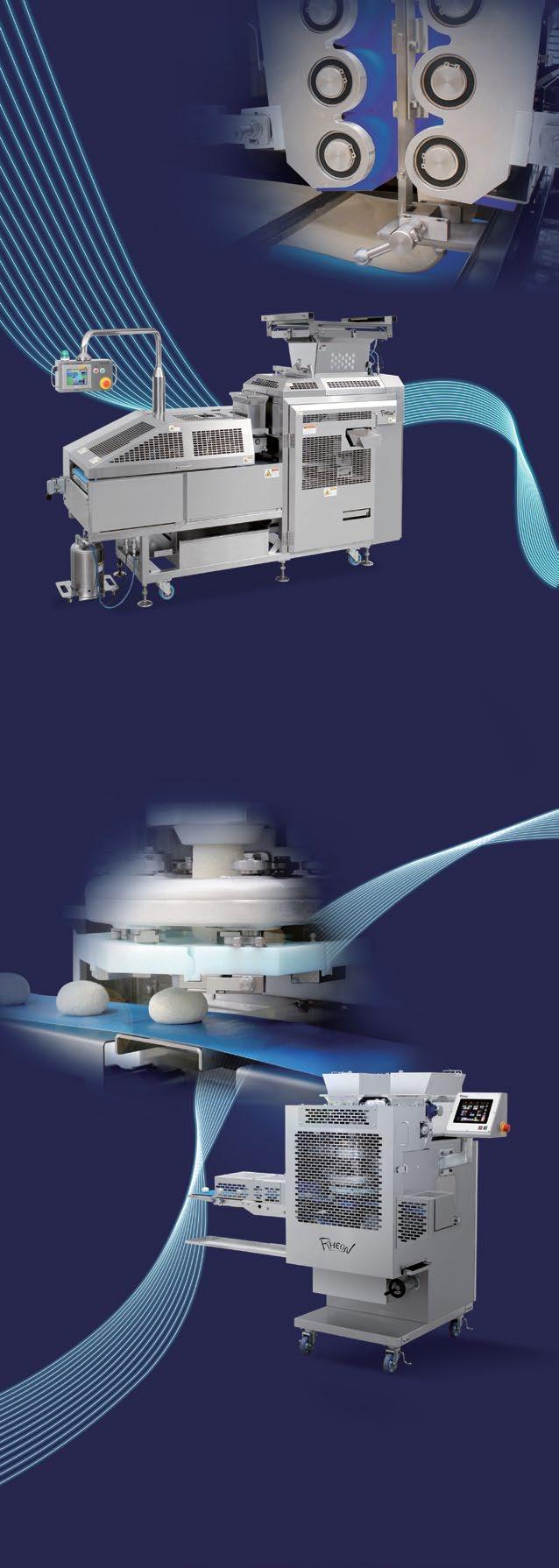





‘tender loving care’, but also: “The three most important things in terms of maximizing the working life and day-to-day performance of a steel bake oven belt are tracking, lubrication and cleaning (TLC),” IPCO underlines.
In terms of tracking, under perfect conditions, a high-quality belt on a properly designed conveyor will run straight and true. However, such conditions are rare in a working environment – temperature changes alone will cause the belt to track one way or the other over time – so steel bake oven belts require some form of tracking. For retrofit installations, the company usually recommends its Compact Belt Tracking 2G system, which uses an optical sensor to monitor the position of the belt edge and enables immediate corrective action, in case of any deviation. “For clean-sheet installations or system upgrades, we can provide integrated active tracking that also incorporates belt tensioning,” says the specialist.
Lubrication minimizes friction, reduces wear, prevents belt distortion, and mitigates the risk of rust caused by condensation. Graphite skid bars are usually the answer, but IPCO can recommend other solutions if needed.
Cleaning, probably the most important maintenance task for bake oven belts, is often a task that can be dirty, difficult and time-consuming. Caustic soda, dry ice, detergent and baking release agents are traditionally used. As a new
First announced in July, the acquisition of the French Mademoiselle Desserts Group was successfully completed. Swiss milk processor Emmi is expanding its market presence in the strategic niche of premium desserts, with this move. The product group currently accounts for 9 % of Emmi's total sales, with Mademoiselle Desserts accounting for around 17 %.
Mademoiselle Desserts specializes in premium patisserie, with 12 production sites in France, the UK, the Netherlands and Belgium. The bakery generated annual sales of around EUR 420 million in 2023 and has around 2,000 employees. Mademoiselle Desserts products are available both in retail, particularly in the in-store bakery sector, and in food service. “We are thrilled to officially join the Emmi Group, a key player in the international dairy market. This integration marks an important milestone in the history of our company, opening new opportunities for growth and innovation by creating the ‘Desserts Powerhouse’ with Emmi Group’s factories based in Italy and the United States. We look forward to working hand in hand to continue offering our customers high-quality, delicious, healthy and safe products, always
development for efficient cleaning, IPCO offers a laser cleaning treatment that does the job in about half the time. “The laser is installed above the belt and the beam is focused on an area approximately 75 mm wide. As the belt travels under the laser, carbon deposits are burned off and collected by a vacuum system. Cleaning can be carried out at a rate of between 10-15 m2/hour, depending on the level of build-up, and the entire process can be managed by a single IPCO engineer,” the specialist explains.
The more efficient the overall system, the greater the energy efficiency. All components contribute to optimum processing if they are set up and managed correctly. For conveyors and their belts, the bigger picture means checking that, “The terminal drums, rollers and skid bars are aligned horizontally and at right angles to the center line of the longitudinal axis of the oven line. Checks should also be made to ensure that terminal drums and all rollers are rotating freely and the tension device is functioning correctly,” IPCO recommends.
Energy savings are made starting with the oven and all related components, one of which is the conveyor belt. But, savings (or unexpected losses) come from any piece of machinery and process setup. While some things are meant to work unchanged for a long time (steel belts), new developments and approaches are coming in to help bake more efficiently. +++
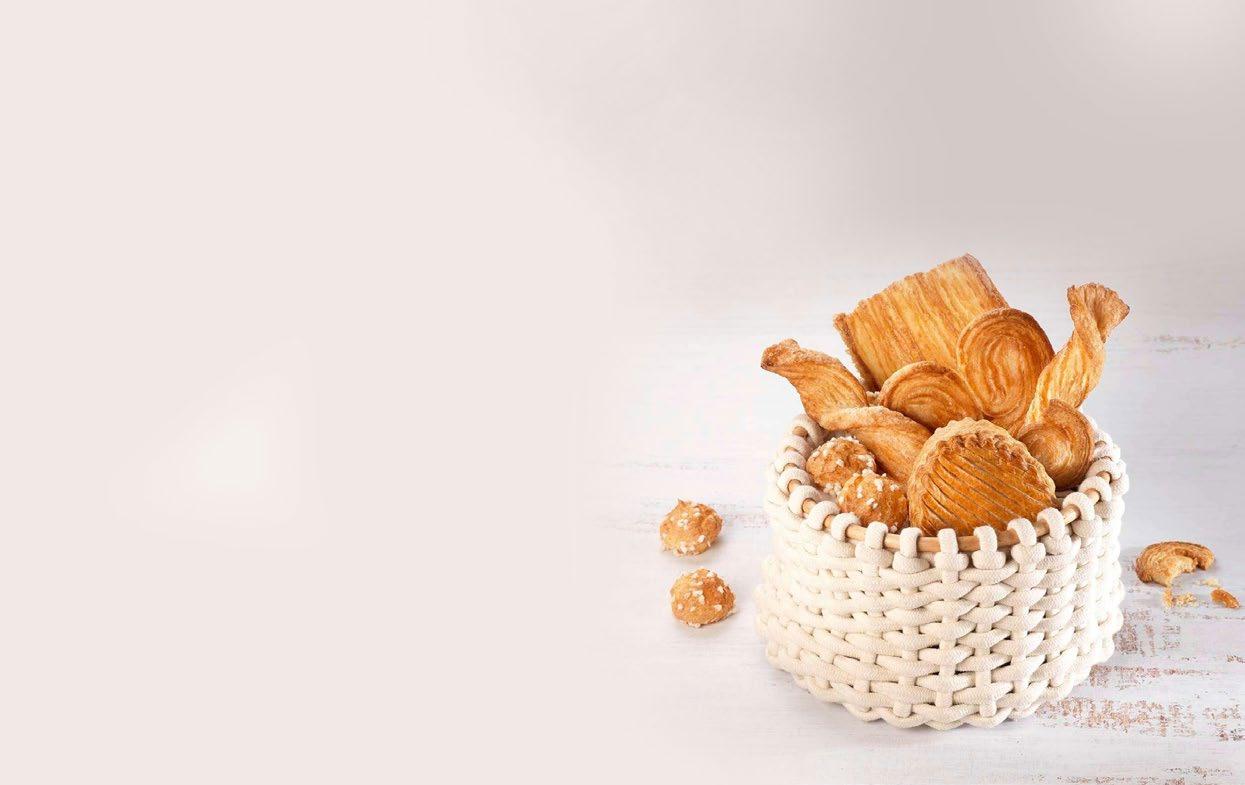
with a touch of indulgence, while preserving our core mission to provide the best cakes and desserts to everyone. We are embarking on this new adventure with delight, passion, and commitment,” Mademoiselle Desserts wrote in the acquisition announcement. +++


From its home base in Zaandam, Lika Bakery shows its excitement and skill in product innovation. Its new, award-winning creations are proof, joining an inviting product portfolio.
+Historic windmills, picturesque canals and traditional Dutch architecture: Zaandam is a beautiful city in the Netherlands. It made such an impression on Monet during his months-long stay there that it inspired several paintings. It’s not only its beauty that makes Zaandam a popular destination among tourists; the town is also renowned for its delightful local cuisine. Lika Bakery proudly contributes to the region’s flavorful culinary offers, coming from the town known as ‘the Dutch true food capital’, thanks to its history and diversity in the food industry. The business founded in 2016 thrives on experimenting and baking. From ideas to fully realized products, Lika Bakery is getting inspiration from cultures all over the world to combine traditions and innovations, for its flatbreads, world breads and buns. Products from Lika Bakery are sold all over Europe, in retail and foodservice.
Their reach and curiosity do not stop there: in March, Lika’s team and ideas traveled to Japan, where they took part in Foodex 2024, as a part of the Dutch pavilion of exhibitors. Its trade show travel agenda also included PLMA and SIAL.
In March this year, the Dutch bakery received an innovation award for Best Bakery Product for its vegetable breads, at IFE’s World Food Innovation Awards. It was their second time exhibiting at the event in London. What makes these breads unique is their distinct color, which comes from the real vegetables used in the recipe. The range includes spinach, carrot and beetroot breads, “A clever and quite transparent way to add vegetables to a meal and diet,” underlines Mariana da Silva, Marketing and Sales at Lika Bakery. “Our vegetable breads are rich in fiber, low in
sugar and low in salt, making them perfect for healthy meals,” she adds. And, a new acknowledgement recently joined the bakery’s collection, for winning the Plant Based Taste Awards.
It’s been a year of different accomplishments for Lika: seven months ago, the business earned the BRC A certification, the highest level of compliance within the BRC Global Standard for Food Safety.
In the spring, the company also launched its new website, available in several languages, and designed for professionals in the retail and food services industry, including cafeterias, supermarkets, restaurants and in-flight catering services. In addition to an introduction to the company, it serves as a platform for an open invitation for collaborations. The bakery shares the thought process behind the enticing creations it suggests “We want people to realize that Lika bread can be enjoyed every moment of the day. If you want

something sweet for breakfast, try our flatbread with some good chocolate paste and some delicious strawberries. For lunch, why not have a flatbread stuffed with hummus and some vegetables? Also, don’t forget the delicious Dutch cheese. And, for dinner, you can have a super gourmet salmon burger, served with our trendy-looking street-food bun.” Its bread assortment is meant to invite culinary creativity.
‘The power of flour’
Lika Bakery draws inspiration from Lebanese bakery in its creations and traditional techniques, from flatbreads to burger buns. They use ingredients from local sources. All its flour, for example, comes from a local artisan miller, George Pijnappel and the Four Winds Mill, which has been in business for over 100 years. Lika chose this supplier because of its artisanal quality, 100% made in Holland, as well as the values they share with the family business: good breads needs natural flour. The authentic Lebanese smell and taste of the bread comes from this special blend of flour. It’s one of the reasons why Lika uses ‘The power of flour’ as a motto.
“We try to source our raw materials according to core values, prioritizing sustainability and environmental responsibility.



”Embracing the power of details is part of our philosophy. We don’t want to overlook anything. We strive to be sharp in every aspect. Continuously surprising. Our goal is ambitious: to become a global player in bread.“



















Sustainability in action: Recycling bread waste saves waste in production.
Bread that cannot be sold due to visual defects does not have to be thrown away. Waste bread recycling, where the bread waste is crushed, liquefied and added back to the dough, allowing them to be put to good use – and even improves the quality and taste of the dough.
We have the solutions to make your plant suitable for bread waste recycling: With our specifically designed components, bread waste rises to the occasion.

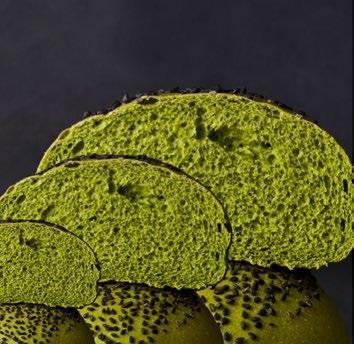

We try to maintain our supply chain in the Netherlands, to avoid deviations and complications in the chain,” the bakery explains. As production is always adjusted according to the demand to prevent waste, its raw material inventory fluctuates accordingly every month, making it more practical to source locally.
All of Lika’s product ranges are baked daily in its Zaandam bakery. Two production sites are set up, with the offices right above them. From here, they are delivered anywhere in Europe, from Amsterdam to Dusseldorf or London: “ordered today, delivered tomorrow”.
The bakery currently produces flatbreads in five variations: white, wholewheat, with carrot flavor, spinach and beetroot (and there are already some exciting ideas for other new, unexpected and delicious flavor proposals). The recipe changes have no impact on the process, so the resulting quality remains consistent. As the production site’s doughmaking operation was just starting, it took extensive trial and error to perfect the original flatbread, Bangin Yussif, Lika Bakery’s owner recalls. The search for the right materials led them across the world, for the perfect combination of raw materials. “That is when we thought to include vegetable scraps into the flatbread. We reached out to companies –mostly juice producers, as they leave quite a lot of vegetable leftovers behind. This is how the recipes were perfected. And, there is also a sustainable component to our breadmaking,” he explains. At Lika Bakery, they pay close attention to sustainable practices.


A Mediterranean favorite, the flatbreads created by Lika are focused on the trends of the Western markets. “Bringing a variety of flavors and diversity to your table is our goal,” da Silva says. “We have Lika Bread ourselves for lunch, every day at the office and I love how diverse the assortment is; everyday we eat something different. My personal favorite might be the Turkish Simit, or the buns,” she tells us.
”Our vegetable breads are rich in fiber, low in sugar and low in salt, making them perfect for healthy meals.“
Mariana da Silva, Marketing and Sales, Lika Bakery
Flatbreads are only one of the specialties Lika pays close attention to. Six bun varieties and several world breads with halal, vegan and high-fiber labels. Production varies according to demand and seasons. “For retail, flatbread is the most sold item, while for food service, our most popular choices are the buns and a variety of breads such as Turkish bread, Turkish simit, Surinamese Puntjes and even pitas,” da Silva details.
Innovation requires constant learning and development, Lika strongly believes. A message recently shared on LinkedIn perfectly crystalizes Lika’s business approach as it advances. In their own words, “Sometimes, late at night, you can still see the lights on at Lika Bakery's office. That’s when we’re still working on a pitch, a new product, or another improvement of our products. Embracing the power of details is part of our philosophy. We don’t want to overlook anything. We strive to be sharp in every aspect. Continuously surprising. Our goal is ambitious: to become a global player in bread.
Lebanese flatbread, brioche buns, Surinamese buns, Turkish simit... we're making good progress. Follow us on our journey.”
It promises to be an exciting one, and new partners are welcome, to grow together, as Lika Bakery aims to produce ‘everything that is flat’ and introduce the world of traditional breads to everyone. +++
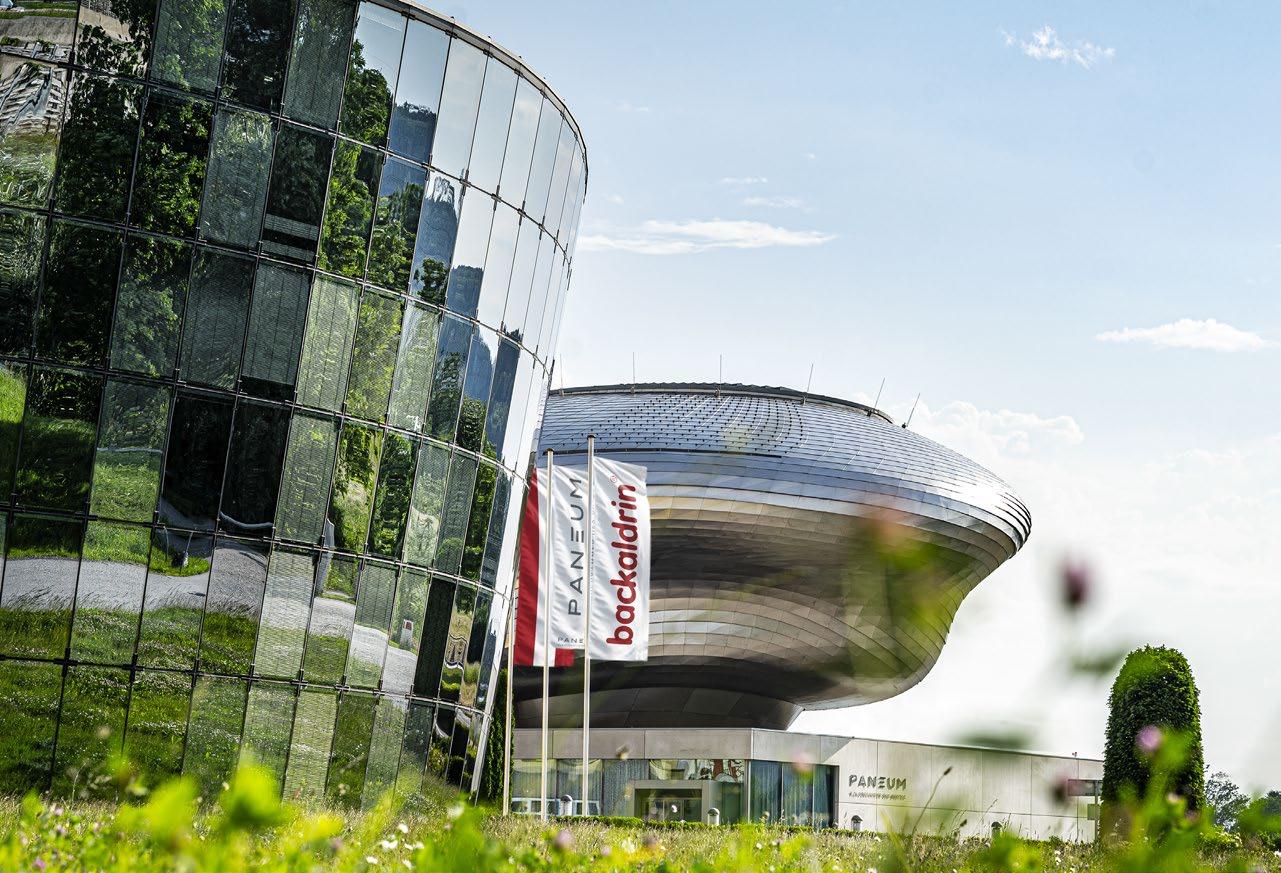

Cookies speak the universal language of taking a moment for a delicious treat, anytime, anywhere. The stakes are high to produce the next favorite creation; but, technology provides different mixing methods to guarantee a perfect start.

+The first step that can make (or break) a great cookie is mixing. When making cookies from scratch, the order of incorporating ingredients plays a crucial role in achieving the desired texture. Generally, the fats go first –usually butter – together with the sugar. The liquid ingredients then join the mix, including eggs, with the powder ingredients (flour) being the last to be added. The challenge lies in managing adjustments to this order and the temperature of the fats used. French mixing specialist VMI recommends using softened butter, and avoiding fats that could be too hard.
“If the butter is too firm, you will need a longer mixing time to achieve the right consistency,” VMI explains. To control the texture, preventing the gluten network development makes cookies softer; in this case, “Avoid overhydrating the flour and do not overmix the dough,” recommends the mixing expert.

However, an optimal approach cannot be set in stone, because best practices will vary significantly according to each cookie recipe. Finding the right balance is where the challenge lies.
Batch mixing is particularly beneficial when there are frequent recipe changes, when flexibility is required, and when running smaller production volumes. It accommodates different production capacities and recipes effectively. When using batch mixing technologies, there are several factors that can enhance the mixing process:
+ Choosing the right mixing tool
Selecting an appropriate mixing tool is essential: a paddle/beater with discontinuous flats or twisted paddle/ beater is often ideal, VMI recommends, as it promotes
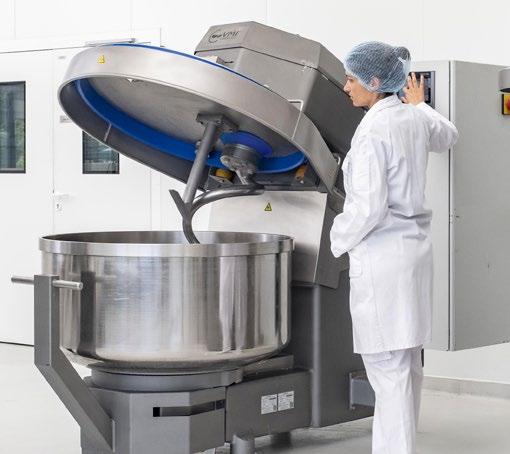
better circulation of the dough within the bowl. This ensures effective mixing, even distribution of inclusions, and the ability to break down and incorporate fat blocks evenly. Alternatively, using regular spirals can be another efficient mixing option that gives good results.
+ The number of tools
Using a double-tool mixer can improve efficiency and speed up the mixing process.
+ Speed control
Adjusting the mixing speed is crucial for optimizing the process. A mixer offering speed variation can help by making more precise adjustments.
”It’s best to evaluate the specific product, recipe, and mixer to determine the exact equipment size needed for the required production volume.“
VMI specialists
Taking into consideration all of these factors for each recipe and specific production scenario, will considerably improve the efficiency of the mixing process for cookie dough. To determine the optimum batch size for the equipment and optimize energy consumption while using a batch mixer, a multi-angle approach is the answer: “It’s best to evaluate the specific product, recipe, and mixer to determine the exact equipment size needed for the required production volume,” VMI explains. Usually, the batch size that can be processed with the same equipment typically ranges between 30% and 100% of the machine's nominal capacity. The specialist illustrates: “For example, with one of our spiral mixers with a 400 L bowl, batches as small as 80 kg can be processed, and as large as 250 kg, depending on the dough’s density, consistency, hydration, ingredients, etc.”
Continuous mixing is synonymous with large-scale production. For this technique, efficiency and consistency are paramount. The corresponding technology, continuous mixers, are usually fully automated, ensuring that quality is maintained consistently throughout the process, from dosing to mixing. They are the most efficient for processes with few changes in recipes. Furthermore, these mixers offer great control over dough temperature, which can help to reliably achieve the desired texture and consistency in industrial cookie production.
However, using continuous mixers for cookies involves navigating some key differences compared to continuous mixing for baked goods like bread. One primary distinction is ingredient introduction, VMI notes: “Continuous mixers generally require a specific order: powders are added first, followed by liquids, to ensure proper pre-hydration
before mixing in the main mixing chamber. In contrast, cookie production often involves a different sequence, where fats and inclusions need to be incorporated effectively at various stages of the process. The inclusion of mix-ins like chocolate chips requires careful management to ensure they are evenly distributed and remain intact, preserving the desired texture and appearance of the final product. For this reason, they will often be added later in the process.” The design of the continuous mixer and its dosing units must take these elements into account. The tool should also be suited for mixing unstructured doughs effectively.
Addressing all these unique requirements maximizes the efficiency and consistency that continuous mixers can offer for cookie production.
To navigate the differences and make the most out of both techniques, thorough recipe testing is a must, along with expert help with the technology. Mixing processes can be tailored to accommodate any variations needed, for best results. +++


Inspiration for next year and beyond takes center stage in Stuttgart, with the 30th edition of südback lining up the best and latest solutions for bakery, confectionery, coffee, chocolate, logistics, training and more. It’s time to plan for interesting updates and meetings.

+The most anticipated event of the year is almost here. International exhibitors are bringing the latest developments for the baking and confectionery industries to südback; several competitions will crown this year’s excellence in craftsmanship and innovation, and a full agenda of forums will be hosted for knowledge sharing.
The 14th Trend Award winners were announced from over 40 nominated solutions, highlighting outstanding concepts in the baking industry, product designs and technological innovations. VEMAG is the award’s winner in the ‘Technology’ category, a recognition it gained for its automation solution for filling sheets, baking tins and cake rings. “With the new FT722 filling table, we are providing companies with a solution that enables them to better cope with current challenges such as staff shortages or rising costs,” said Christoph Thelen, Managing Director of VEMAG Maschinenbau GmbH. Schneider GmbH earned the award in the ‘Sustainability’ category, for ‘Greeny’, a biodegradable and compostable piping bag. "Our disposable piping bag 'Greeny' is a sustainable product that contains no plastic and is suitable for all bakers, confectioners and restaurants,” explained Jochen Schneider, Managing Director of Schneider GmbH. In the ‘Marketing, Sales and Organization’ category, the winning innovation is an AI-controlled tool for cashless, autonomous branch management – BÄKO-AutoPOS, presented by the BÄKO Head Office (BÄKO-ZENTRALE eG).
“The automated processes increase efficiency in branch operations while the digital payment prevents cash differences,” said Stefan Strehle, CEO of the BÄKO Head Office in Duisburg. Werne-based UNIFERM won the award in the ‘Raw Materials & Convenience’ category, for its UNIFERM FermFresh ® AromaDurum, which combines the advantages of sourdough fermentation and yeast fermentation. “Fermentation is a viable and innovative concept,” emphasized Elke Preissler, Head of Corporate and Marketing Communication at UNIFERM. All the winning companies (as well as a yet-to-be-announced winner in the ‘Public Favorite’ category) will present their products and concepts at südback and will officially receive their award in a ceremony held on Saturday, September 26, at 9:30 AM, during the show’s opening event.
The 15th Carlo-Wildt Trophy is also up for the taking. This year’s theme for cake decoration is ‘rural life’. Contestants will be evaluated on creativity, craftsmanship and the cleanliness of their workstations.
With the Baker Trend Forum, südback will set the stage for conversation around all noteworthy new developments in baking. The four-day program includes a comprehensive array of topics including Artificial Intelligence, sustainability in the bakery, staff recruitment, using new technologies, sustainable planning and construction, leveraging social media opportunities, and practical tips. “In the varied discussion rounds, you will learn from experts and industry insiders about the opportunities and challenges that the future holds,” südback’s organizers anticipate.
The Confectioners' Trend Forum will also bring together experts to analyze the latest trends, techniques and strategies. Topics will include training, successful sales strategies, new ideas and solutions for the daily work in cake shops and cafés, as well as innovation in the presentation of goods. Kevin Kugel, one of Germany's most renowned chocolatiers, will also share his knowledge in Innovative praline pastes packaged in a contemporary Christmas design’.
Another highlight in the agenda comes from Blackforest Grain GmbH, who will showcase ‘Upgrain’, a wheat-like powder obtained from spent grain resulting from beer
+ 35,384 visitors
+ ~600 exhibitors
+ 18% international visitors
+ 65,000 sqm exhibition space

production. Low-carb and high-protein, Upgrain is a promising alternative for the confectionery industry.
In addition, the national qualifying round of the World Chocolate Masters will come to südback for the first time. This year, the theme of the competition is ‘Play!’. The International Final will be held in Paris in 2025. Chocolate will also be covered with solutions for production at the
exhibitors’ stands. “The trend is clearly towards unique choco late products with character and creations that stand out from the crowd. Healthy ingre dients, luxury vegan foods and as little sugar as possible are also in demand. We want to give these trends a stage at südback,” said Andreas Wiesinger, Executive Vice President of Messe Stuttgart.
Another bakery-adjacent product will have its well-deserved highlight at the fair: coffee – one of the most consumed beverages in Germany, with concept solutions and new products for bakeries, cake shops and cafés.

The next südback will not take place in 2025, as it would usually be scheduled, and will instead be held from October 24 to 27, 2026. In 2027, südback will take a break, as usual, before being staged according to its normal frequency cycle, in 2028 and 2029. +++



RONDO launched its most recent automated line for bread production, the Smart Bread Line, at iba 2023. It was designed to make more bread, faster, while reproducing artisan quality.
+A market analysis dedicated to the world of bread allowed RONDO to identify a specific need in the small-medium industry segment for a flexible and modular line that would make different types of bread, an allbreads-in-one-machine concept. The experience of designing the ASTec industrial lines helped in designing the Smart Bread Line, RONDO explains: “In fact, we took advantage of our expertise to create a line capable of responding to semi-industrial needs while guaranteeing a final product with an artisanal look.”
With a modular configuration, the new bread line can process up to 1,000 kg of dough per hour for a wide range of breads. It is designed to improve ergonomics in production environments to increase efficiency and labor efforts. “The simplicity of use and ease of mobilization of the individual modules makes it a versatile and high-performance line,” its maker highlights. The modular design of the Smart Bread Line allows setups for the production of all bread categories, either cut, stamped, rounded, or molded. Niche and special requirement products such as gluten-free bread can also be made. “It is possible to create over 1,000 recipes,” RONDO adds.
The equipment changeovers are fast and easy to make, the specialist explains. Additional products can be added into production by replacing tools, such as the blades or molds. “The Smart Bread Line was created to have the product change as quickly as possible. Obviously, this depends on the workload, the number of families of bread products made, and the space the company has available in the production area, to name the main factors.” The line was
created to meet the production capacity of 1,000 kg/h in a word schedule of two shifts per day.
The operator was also factored into the design of the line: programming, diagnostics, the speed of the conveyor belt and the thickness of the dough band are managed via HMI, for user-friendly operation.
Gentle dough processing was a priority; it is ensured from shaping the dough band through to placing the formed products in trays. This enables the Smart Bread Line to process all kinds of dough, especially difficult types such as highly hydrated and pre-fermented dough, with close control over its structure.
Among the new technology developments that come with this bread line, the RONDObot is a notable feature. It is a round molding system that can process highly hydrated dough with long resting times. It is suitable for producing round rolls in various weights, shapes and sizes, contributing to the line’s flexibility. In addition, “RONDObot is an innovation in the oval molding process. The new cross-rolling movement of RONDObot permits the formation of oval shapes from small to big loaves,” says the specialist. The system can change between tools automatically, so that molders of different sizes can be used. Its rounding speed, number of rotations and width are all managed by its built-in software, with no mechanical intervention required. Several working cycles are available:

+ Standard rounding movement (round shaping)
+ Cross-rolling movement (oval shaping)
+ A combination of the two movements
There are various additional features to choose from, to customize the Smart Bread Line to specific needs, such as different automatic feeding systems, different automatic seeding units and different automatic panning units.
Options for feeding systems include stocking hoppers with a feeding belt, floor-level stocking hoppers with a feeding belt, or just a feeding belt. For product differentiations, automatic seeding units are available, either top seeding units, or seeders for the top and the bottom of the product. For panning automation, one option is a unit with one or two trays, or a panning unit with an automated tray circuit.
“The different options are available to meet the customer’s production requirements. The objective remains to simplify work and reduce employee workloads,” RONDO explains. Safety and hygiene were also integrated into the design of the Smart Bread Line. In order to guarantee the integrity and safety of the final product, RONDO applied the same production methods when building the Smart Bread Line as those used to make industrial ASTec lines: “We apply the MOCA regulation, which serves to certify compliance with hygiene standards and to regulate the food contact of materials, such as steel, in our case.”
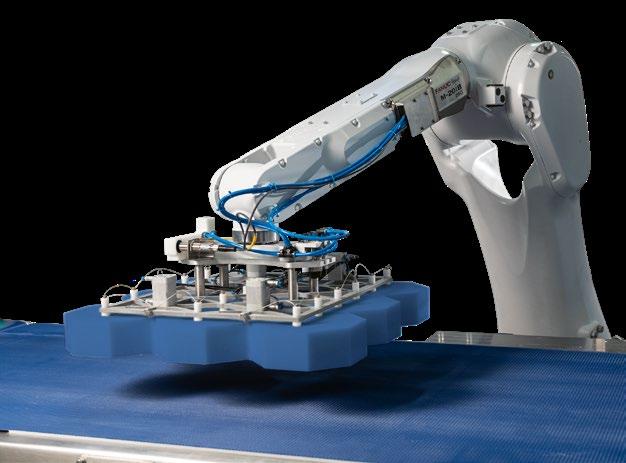
When baking fresh products, RONDO recommends changing the tools in line with the programming, respecting the logic per product family, to optimize production effiency: “We therefore want to avoid changing molds or blades in an unorganized and confusing way. This will save you time and money.”
Balancing product diversity and the optimum process efficiency requires a flexible technology solution, which takes all production steps of an array of products into consideration. It is also a matter of correctly planning the production using the line, throughout the day, the week and all year round. +++

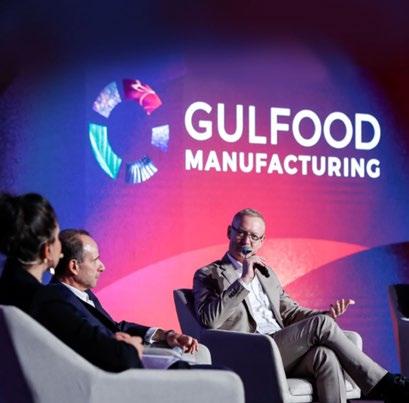


As the Middle East’s landmark event, Gulfood Manufacturing gears up to celebrate its first decade from November 5 to 7, with exponential growth.
+ Organizers anticipate that the 2024 edition will be a catalyst for industry transformation comprising the latest-generation technologies and new solutions. The milestone installment of Gulfood Manufacturing is shaping up to be the the biggest yet in the 10-year series, with a 29% increase in show size and 25% first-time exhibitors.
“This year, we’re at a pivotal moment in the food and beverage manufacturing industry. This is your opportunity to dive into the latest innovations, fast-track technology adoption, and confront the challenges of tomorrow head-on,” the organizers anticipate.
More than 2,500 exhibitors will join this year’s Gulfood Manufacturing, including new pavilions, reflecting the show’s role in connecting global manufacturers with the European, Middle Eastern and African markets. Over 45,000 professional visitors have confirmed their participation, including C-suite executives, procurement heads, R&D leaders, design architects, technologists, nutritionists, consultants, engineering specialists, and factory and plant owners.
The Foodtech Summit will be held at the Dubai World Trading Center together with the exhibition, with over 100 expert

authority voices in the food industry joining to power conversations on current hot topics, including food engineering innovations, metaverse factories of the future, food safety, circular ecosystems, sustainability-linked finance models, and a masterclass in clean label strategies.
Held during the first day of the show, a CEO’s Corner is also on the Summit’s agenda, promising to bring visionary leaders into the spotlight for a conversation around a smarter, more sustainable food industry. Panelists will include Edmond Scanlon, CEO - Kerry Group, Alvaro Martinez, Regional CEO - GEA Group, Heiko Feuring, President –Bühler Group, Matthias Moser, Managing Director, Food Ingredients Division – Stern Wywiol, and more. The key talking points will include navigating food evolution manufacturing with confidence and strategic partnerships, building a sustainable food system to feed the future, enhancing sustainability across the factory floor (technology to support food security), ethical considerations, waste reduction, efficiency, affordability and decarbonization.
The Industry Excellence Awards 2024 are also a notable event during Gulfood Manufacturing. They are granted to pioneers in the food industry in recognition of innovative products and technologies that have made outstanding contributions to the industry, encouraging more companies to invest in technological innovation to improve productivity, and convenience while achieving sustainable development.
The Hall of Fame debuts this year as a 10th-edition special feature, a dedicated space at the Pavilion Hall where groundbreaking technologies and innovations are highlighted through dynamic screens. In addition, Innovation Tours are also organized by exhibitors to unveil new launches and technology innovations.
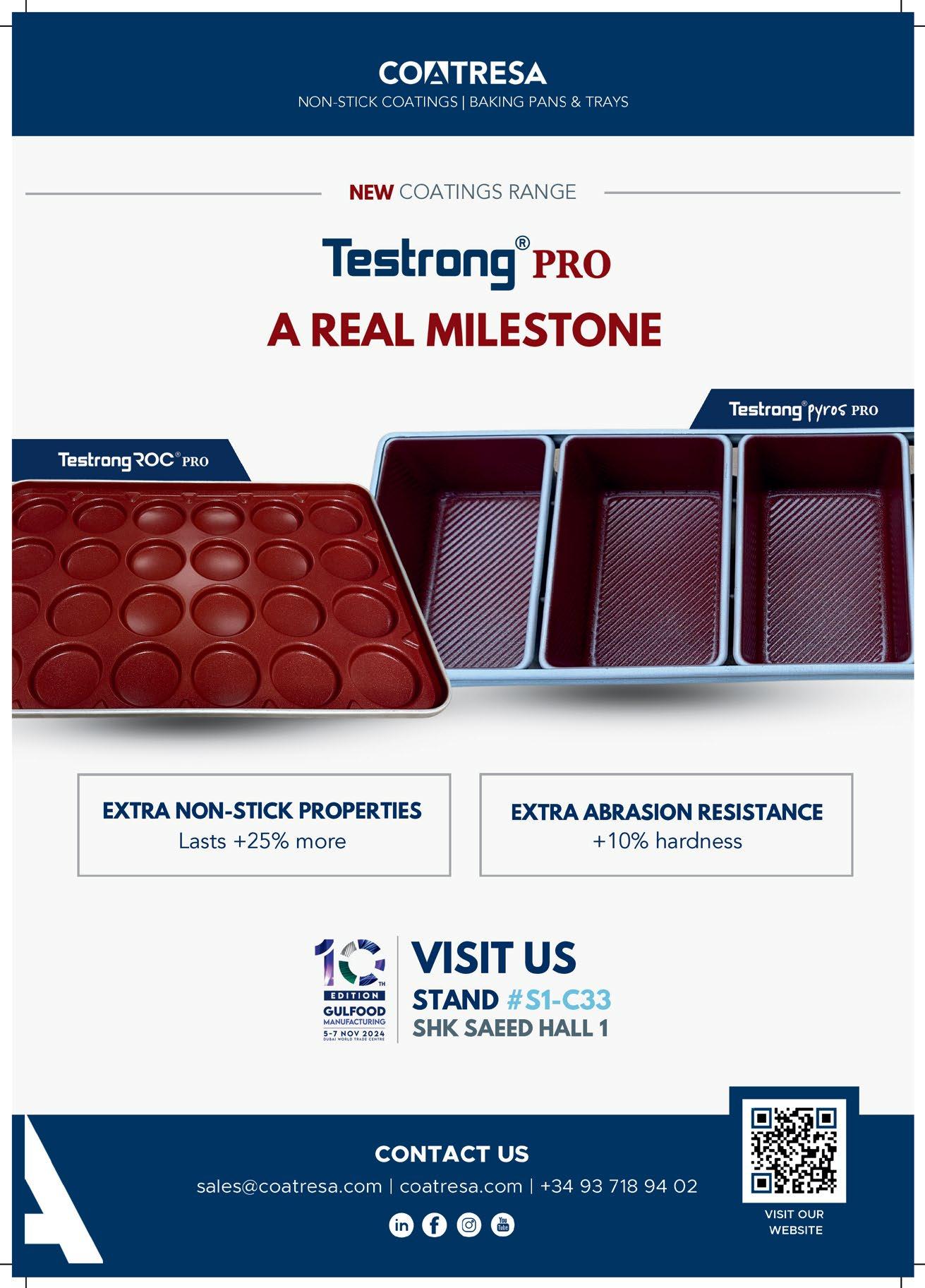

In May, Bühler relocated its Biscuit Business Unit and Nordics Services & Sales (SAS) organization to state-of-the-art offices in Copenhagen, Denmark. As part of the change, Haas-Meincke A/S, which was acquired in 2018, was renamed Bühler Denmark A/S, to reflect its complete integration into the Bühler Group. Morten Riisager, Head of Business Unit Biscuit, Bühler Group, and Managing Director, Bühler Denmark, shared his thoughts about developing solutions for the production of biscuits.
+Catalina Mihu: The new offices were recently inaugurated. What was the strategy behind the decision to relocate the Biscuit Business Unit and related services to Copenhagen?
Morten Riisager: As things are starting to settle in our offices, we are finally starting to enjoy the efforts we put into this move, and the new environment. It is a project we worked on for a very long time and a significant milestone. We embarked on this project for two reasons, mainly: first of all, the biscuit business, including the Meincke brand, would have its own dedicated space; and, secondly, we have the opportunity to merge with the Bühler Nordic sales and service office that was previously based in Malmö, where it had been located for over 100 years. Since we we have been working closely together for around six years, the decision to merge the two made sense. Synergies were created, as we share some of the same functions. It also brings us a bit closer to the market, because we, as the business unit, are the ones who supply the next solutions to the market, and to do that, we need to ensure we can develop the right solutions for our customers. The Nordic region business is very close to the customers themselves, on a daily basis. We need to be very close together when we reach out to the customer, so the synergy stemming from working under one roof further emphasizes that we are Bühler, one organization with a reach that extends beyond just biscuits, to the entire process chain. We are a complete solution provider, from grain handling up to the finished product. And this is a synergy we are creating by being under one roof.
As for the reason why we made this change for our biscuit business itself, it is because we need to be prepared for the future. The move will help us ensure that we are able to adapt as the world is changing and the market develops. The new office can support our needs for the future. I firmly
believe that our physical environment affects our mindset and the way we work; coming from offices styled by the trends of the ‘80s, with separate spaces for each department, into the new environment, which is a modern, open space, the fact that we are able to see each other every day reinforces our sense of belonging to the same team; we work together and have immediate opportunities to collaborate, between departments, within one department and personally. Especially in light of having other Bühler in-house, the new space invites us to cooperate more closely, which we do need.
Thirdly, we saw the need to create a new environment not just for our own employees, but for our partners as well –our suppliers and customers, and for institutions we work with, such as universities. We now have a space where we can come together to solve the various challenges in our path, from efficiency and process-related issues coming from our customers, to larger-picture goals we need to work towards, such as managing our inevitable environmental impact. We need to come together and solve such challenges, and we want to do so in an inviting environment. Our new spaces emphasize supporting cooperation. We created different spaces in-house that can attract new
employees and potential suppliers – as a way to prepare ourselves for the future. We are creating a powerhouse, a collaborative space that will enable us to become an even more attractive supplier to the industry.
And not least, we are literally in an extraordinary position here, in Copenhagen: Lund University is only about 55 km from here, just on the other side of the sea, in Sweden. Malmö University and Copenhagen University are also very close by, and so is the Danish Technological Institute. We have so many institutions around us where people from around the world come to enroll.
Mihu: Are you collaborating with these universities already?
Riisager: First of all, we want to attract new potential employees – students from these academic institutions for the future. And, we see it as a need, to cooperate more closely with them, to bridge the gap between academia and the industry. That’s the way forward, in our eyes. And we are situated in the middle of this space. We need and we can benefit from this proximity, which is why we created this space where people would immediately feel they would like to come and spend time.

to the Bakery Mirror newsletter,
to your inbox every other Wednesday. www.bakingbiscuit.com


Mihu: The new Copenhagen headquarters has offices and meeting spaces for a staff of around 240 people. What did the relocation entail, and what steps were involved in the move?
Riisager: The Bühler Nordic office was very close to the Haas-Meincke office and factory, with roughly about 35 km between them. It didn’t make sense to keep them separate. A big part of the process was integrating the Bühler Nordic sales and service departments into the new environment we created. Logistics-wise, the building itself and spaces were set up very quickly. We reached the decision at the beginning of the year, in January, and we were lucky enough to find the right facility just across the street from where we were. This is why we were able to establish the new office in only three months: we rebuilt the interiors and decorated the space according to the standards we have at Bühler so that it reflects who we are as a group. And, we still have the old facilities, where our Biscuit Application and Training Center is located, only 200 m from here.
“This relocation is a significant milestone in our company's development. It creates a Bühler powerhouse in the Nordics, lays the foundation for advancing our biscuit business globally, and reinforces our presence in the Nordic countries.”
Morten Riisager, Managing Director, Bühler Denmark and Head of Biscuit Business Unit
Mihu: Will it still be in use there?
Riisager: It will definitely be used until a new application and training center in connection with our new office building has been completed, which is expected to be by mid-2025. Our Application Center is virtually the heartbeat of our company, because this is where our customers come to see our solutions and we can showcase how the machines perform. Here, they can get help to develop their next recipes, and perfect the next products to be released on the market. It is always fully booked, often months in advance.
Mihu: Could you give us a quick guided tour of the facilities at the new headquarters now?
Riisager: First of all, we made a much more welcoming reception area. We consider it important, as it is the first point of contact when arriving here. In addition, we want to show that we are not the old Haas-Meincke anymore, we are Bühler. This is what the change is all about, to show that we are a part of Bühler and have effectively become so, including the use of the global facilities and the global service network that we have within the Bühler organization. The first message when entering is a sense of ‘this is
Bühler’, with everything that the group can provide. This is the message we showcase in the branding room, which is connected to the reception. Here, we can tell the story of Bühler and how everything is correlated within the organization. On top of this, we have our sales, customer service, engineering, project management, portfolio and marketing, R&D, and the administrative departments working in house.
Mihu: As the integration of Haas-Meincke is now complete with this move, which included its name change to Bühler Denmark A/S, what was the role of the acquisition in Bühler’s long-term development plans?
Riisager: The Meincke brand complements the Bühler business; it connects how we, as a business, support the biscuit industry, from the moment the ingredients are received, then mixed, followed by shaping and baking the product. Bühler provides all the knowledge ahead of the processes covered by Meincke: all the grain handling, and ingredient handling including chocolate, starting from cocoa beans until the finished chocolate product. By having these fully integrated, we can now provide a full-service package, complete solutions. In addition, we also have a global service network set up; by integrating Meincke, it gained access to this global network. This means a lot to our customers since any solution provided will require service. We have a much better foundation for supporting and developing a better relationship with the customers. In this way, the strategy of the procurement and integration of Meincke into Bühler makes perfect sense. This is why we need to tell this story clearly to our customers, and we have started doing that by steering away from the Haas-Meincke name and transforming it into Bühler Denmark.
Mihu: Just as the welcoming area, the brand presentation is also how first impressions are made. Did the benefits of the integration in this way outweigh the value of the name HaasMeincke had established for itself, before the acquisition?
Riisager: We still keep the brand Meincke on our machines, which reflects the technology itself. In turn, Bühler reflects the organization and the entire global setup we have. Simply put, that is what the customer is buying, the Meincke technology and full access to the Bühler organization and products.
Mihu: So, in this way, the name of the technology is still here, and its brand?
Riisager: Exactly! And that is precisely what we need to tell the world, and our customers – that it is now a part of the Bühler organization, which is much more powerful than what Haas-Meincke used to be.
That’s why it would have been wrong to keep the name of the company, as it doesn’t reflect who we are anymore. We are Bühler, with Meincke technology.
Get ready to experience a match made in pastry heaven as we bring together the delights of Dawn and Royal Steensma. From celebrations big and small to those everyday moments, our combined expertise and talent for taste will bring you even more sweet inspiration and innovation. The perfect mix of sweet bakery ingredients and your partner for bakery success.
Why settle for one when you can have the best of both worlds? After all, some things are just meant to be together.
Dawn & Royal Steensma: Simply Irresistible.

Scan to learn more about our recent product launches
Mihu: And the expertise that is already established. Riisager: The expertise is already established and known, that is correct. That is why the center of competence for biscuits is in Denmark. We can channel the expertise we need here, from the other industries we specialize in, from flour to chocolate, or mixing. By having representatives from our other business units here, we do have a link to the world, directly in our house.
Mihu: So the biscuit HQ is in Denmark. From this hub, what are Bühler’s latest developments in biscuit production today? Riisager: To start by mentioning something that is not new, but especially relevant today: we’ve had electrical ovens, for years. We recently developed a new version of our electrical ovens that we are offering to the market, which aims to provide a more energy-efficient solution; it was launched two years ago. On top of that, we launched
the Meincke Turbu E in May this year, a zero-emissions baking oven, a fully electrified oven as well as a retrofit kit enabling the change from gas to electricity. As a mixed energy solution, we have launched the Turbu M: this oven has both gas and electrical heating modules, so the customer can have the choice to make use of both, meaning that the energy sources support each other in the baking process, or the customer can shift between gas and electricity, depending on which energy source is more convenient to use. This is our latest development, in line with a growing request for electric ovens, especially after the energy crisis from two years ago, and with a focus on using more sustainable energy sources instead of fossil fuels. I truly believe in the mixed, hybrid solution we developed, because it makes the oven much more versatile: it helps with sustainability targets and, at the same time, lowers baking costs. To help the customer with their energy savings, we can test the module in our Application Center on their
In line with Bühler’s commitment to optimizing and renewing its production footprint, the production of ovens for biscuit and cracker lines in Denmark will be consolidated into one location in Roedkaersbro, approximately 240 kilometers from Copenhagen. The equipment used in production for processes ahead of baking will be manufactured in Leobendorf near Vienna, Austria, where production facilities were tailored to maximize efficiency, Bühler says.
The Application & Training Center in Copenhagen will continue to support customers in developing and scaling innovative biscuit and cracker products, including the use of new electric ovens.
Johannes Wick, CEO of Grains & Food at Bühler Group, emphasized the strategic importance of this development for the company: “The investment in this new infrastructure reaffirms our commitment to Denmark and our expertise in the biscuit and cracker segments. It also strengthens our capabilities in the Northern European market, where we see significant growth potential.”

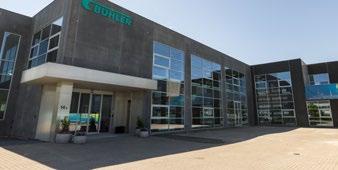

products to see whether recipe changes are needed when using it, how to adjust the oven and the lines, and how to develop new recipes using this technology with the correct settings.
Mihu: Expanding on the topic of technology solutions, from the perspective of the biscuit maker, what is the added benefit of working with a fully integrated system provider, such as Bühler? In addition to the biscuit-specific expertise, what other advantages are available to them?
Riisager: We look at our customers’ needs beyond the work of handling the dough, or shaping and baking a product. We need to understand the entire business and all its challenges, starting with the type of grain/flour they use. In addition, a big component of the biscuit industry is chocolate, for which specific technology is required. Understanding both upstream and downstream challenges is important when aiming to be the right partner for a customer, in my eyes. The better we understand our customers’ challenges, the better we can optimize our solutions for them. I wholeheartedly believe that having a deeper understanding of the customer’ business, the better we can develop ourselves in the future, to be the right partner for them. Having the technology understanding is one thing, and knowing what the producer’s pain points are is another.
Mihu: Because you focus on new solutions for energy efficiency, including electric ovens, what is an image of the requests in the market, from your work with your customers? To what extent is this type of oven technology adopted? Riisager: It is coming. Over the past two-three years, we have tripled our sales in solutions powered by electricity, more or less. So, we do see a lot of requests for it. But, we also see challenges for the industry.
Mihu: Such as?
Riisager: The challenge is to be self-sufficient when using electricity. It is more related to the infrastructure (than the technology itself), in many countries. From the perspective of the governments, it is clear that they would like to increase the adoption of more sustainable solutions, backed by a powerful electricity grid. But, if the infrastructure of the electricity lines going into the factories is poor, then the step cannot yet be made. It’s all connected. We see that many of our customers who want and need to use electricity cannot implement it yet. The opening to use electricity is definitely there. While producers are working on this with local authorities or even at higher levels, they face challenges because they simply cannot get the power they need. Without pointing out a specific country, this problem occurs in several markets, locally or at a national level. It all depends on the location of each factory.
But, this is where the mixed module comes in: with it, you can supply the energy you need. If the full amount of




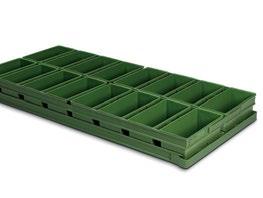

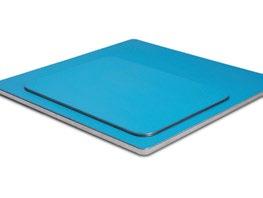

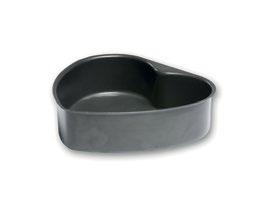

electricity cannot be supplied, it can be used partially and mixed to meet the needs of the baking process. The CO 2 footprint is still improved, in this way.
Mihu: For a map of Bühler’s production facilities, we now have biscuit ovens in Denmark. What equipment is produced near Vienna? How was Bühler’s production footprint optimized with the latest changes?
Riisager: In Vienna, we have all upstream solutions –including equipment dough handling and product shaping. Our ovens themselves are all manufactured here, in Denmark. We are also expanding our manufacturing capabilities in Vienna, in addition to our Denmark site. On top of this, we have production facilities in India, where we produce ovens and will soon expand to some of the upstream equipment for the Indian and other markets. It’s a matter of being close to the customer.
Mihu: When a biscuit manufacturer comes to Bühler for a turnkey solution, how will the project be managed?
Riisager: The project is managed in Copenhagen. Bühler’s global network gathers expertise from different markets for specific projects, in cooperation between customers and experts in Denmark – from project managers to technicians. Our HQ team defines the settings of the lines in close cooperation with our expert teams from different regions of the world.
Mihu: What are some of the tests that are frequently requested at the Application and Training Center? What kinds of tests can be carried out there?
Riisager: The Center is truly at the heart of our work, because this is where we see “the proof is in the pudding”, it's where we can test the customer’s requirements. We might have specific projects, such as a customer testing its own products on a line they are buying. By carrying out various tests, we define the exact baking profile of the product, which they can bring home and input the settings when the machine is delivered. Or, when customers have ideas for new products, they come to the Center to test them with our help and tweak the recipes and/or the settings of the oven. They bake samples and taste-test them as they prepare to bring them to market. We frequently work on this kind of project at the Application Center.
Mihu: You mentioned that it is fully booked. If a manufacturer calls today for an appointment, when is the soonest appointment availability?
Riisager: It is hard to say, but we will find a solution! To put it this way, it is occupied 8 out of 10 days, at least. It is seldom that it is empty. We have two lines running here –a cracker line and a biscuit line, so we have the opportunity to test plenty of products and ideas. We also have a
“Every time we update our lines, our goal is to improve energy efficiency to reduce consumption by at least 10%. We have been able to do this and we aim to continue on this journey. We have done this with the electrical oven, too.”
Morten Riisager, Managing Director, Bühler Denmark and Head of Biscuit Business Unit
Food Creation Center in Uzwil, which was inaugurated just before the end of 2023, where we can test products and integrate solutions with technology from our other business units. There, we can link biscuits to chocolate and mixing, in terms of types of technology available.
Mihu: The Meincke section of Bühler tradeshow stands usually features product innovation ideas and many samples. Will this setup be continued at exhibitions?
Riisager: Yes, it will. It helps to illustrate our work at the Application Center and the services we can provide to our customers, as well as the additional benefits coming from the integration of the brand. For an example of a sustainable product, chickpeas are a high-protein ingredient that can be considered in some countries. We can help develop such products with our customers. Finding new ways of making products or testing new ideas is what we can do for them at the Center, including developing trendy, healthier products and recipes using local ingredients, as well as indulgent, luxury creations, for instance. We see more and more requests for these categories and they will continue to grow over the next 5-10 years, I believe. This is clearly the trend.
Production-wise, sustainability will remain high on the agenda, ours and that of our customers alike. This is why providing sustainable solutions is important to us, and being able to assess the carbon footprint of a line. Being in control of the process is key to optimizing it, which is something we have been focusing on for at least 10 years, starting with our ovens, as the most energy-consuming part of production. Every time we update our lines, our goal is to improve energy efficiency to reduce consumption by at least 10%. We have been able to do this and we aim to continue on this journey. We have done this with the electrical oven, too. Its CO 2 footprint is obviously smaller, and, on top of that, we still aim at lowering its energy consumption needs.
In addition, it is our goal to significantly reduce not just energy, but also water consumption and to minimize waste. We can only do this together with the industry, which brings me back to why we developed this new, welcoming space. Here, we can attract employees, specialists, and host the industry to solve these challenges together. +++

Created to optimize your direct food–contact conveyors, The Intralox® FoodSafe™ System is an unrivaled, in-depth approach to meeting your plant’s daily production goals sustainably.
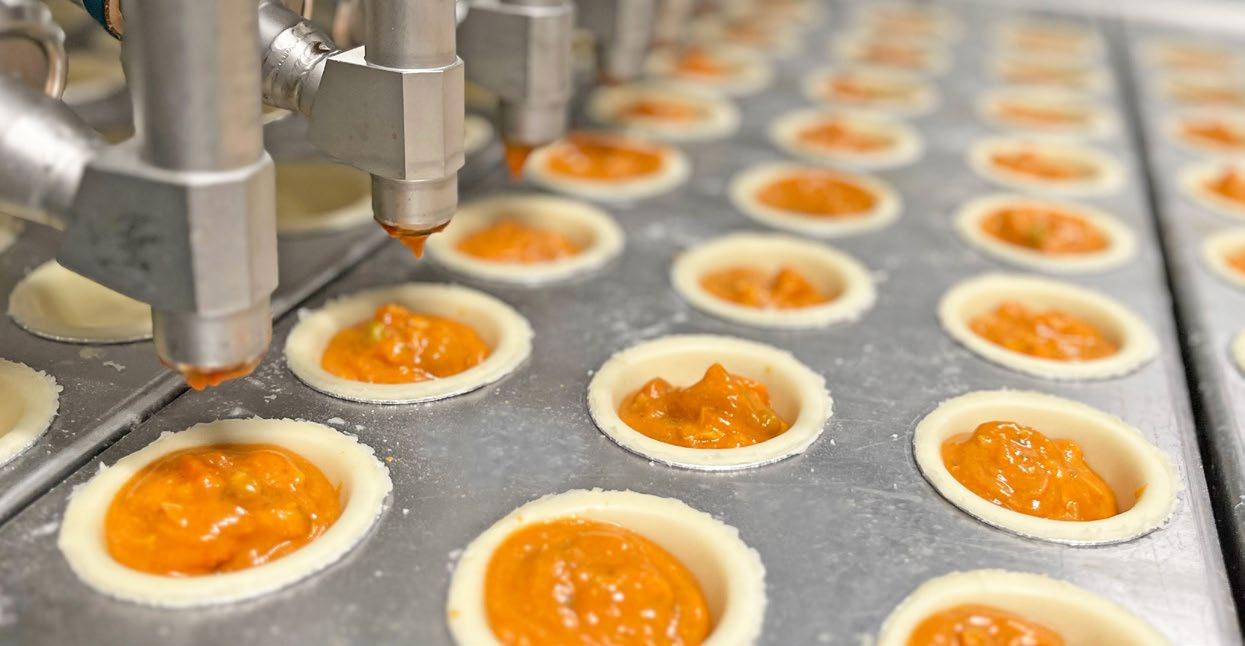
Pies have the magic ability to reinvent themselves with the fresh flavors of every season. But, precious nostalgic memories make them an even more cherished dessert. Creating infinite variations is a great business strategy for such a deeply personal product – as long as it is done efficiently.
+Fruit pies with changing flavors throughout the year, seasonal meat pies, or trendy pasta del nata, hoop pies and quiche – few products offer such a diverse palette for creativity. Whether the pies have an open top – covered with various ingredients, or are closed with dough, lattice, or crumble, the technology needs to produce excellent results no matter the recipe and material changes. Variables do not stop here, either: pies can be made on different supporting surfaces/containers, from foil to paper to metal baking trays, hoops, tins, or indented trays.
The Rademaker Pressing line is engineered to produce an extensive assortment of pies and quiches, covering international cuisines, baking traditions and new product innovations, without configuration changes. When the product size and shape change, for example, the product changeover parts will change to match the new recipe in production: the platterns and blocking dies need to be exchanged. However, the line configuration will stay the same.
When a different product entirely starts running on the line, the process changes are related to the size of the pie as well as the type of filling being used. “Depending on the filling type, it could be the case that different nozzles are needed, or a different type of depositor. Changing a depositor is easy because they are constructed on mobile frames, which makes it quick to swap in and out of the production line,” said Wouter van der Veek, Product Manager. Changing from savory to sweet pies is also possible: technically, it translates into simply using the desired type of filling.
A crucial consideration when dealing with such a vast product variation, which often includes premium, limitededition and seasonal items, is production capacity. “When employing an automated process for making pies, optimal planning of products and runs, will make or break any business,” van der Veeks observes. Carrying out multiple

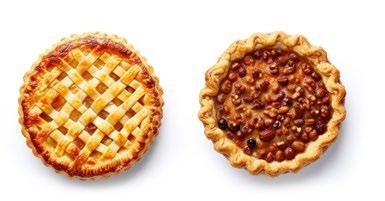
For filling types with fruit inclusions, the most important aspect is to make sure that the fruit inclusions are not damaged when they are processed though the depositors. In case large fruit particles are required in the filling, Rademaker integrates its Piston depositor. It is designed to handly chunky fillings without damaging the particles.
toolset changes frequently can become timeconsuming. Alternatively, ensuring small changes are made throughout a production day ensures that the downtime of a line is minimized.
To optimize production on an automated line, planning can also be optimized with regard to changes in types of dough and pie recipes: processing a single kind of dough per day eliminates the need for changeovers in strip feeders and rolls. Moreover, cleaning the mixers and ingredient handling equipment is not necessary when a single recipe is in production, improving the bottom line. Other aspects that should also be considered for production planning








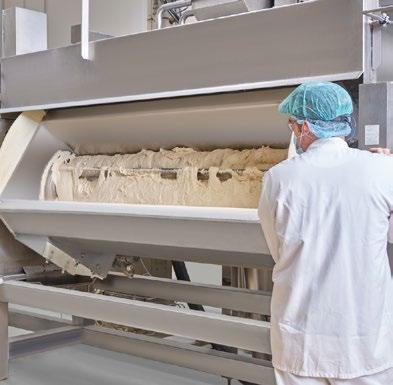


include using different types of fillings, which should be scheduled by color, or allergens they (may) contain. Sorting production sequences correctly can save additional time.
Decoration is an important part of pies, too – one that further adds to their diversity and is often a purchasing decision-maker. Rademaker’s lattice unit can create the decoration pattern in the length/width of the dough sheet, in customizable shapes.
”When employing an automated process for making pies, optimal planning of products and runs, will make or break any business.“
Wouter van der Veek, Product Manager, Rademaker
Fruits come in greatly different shapes, sizes, consistencies and textures. As pie ingredients, they are used both fresh, portioned into pieces, and made into jams. For fruit inclusions and all fillings in the fruit family, the first priority is to ensure that the fruits are not damaged when they are processed with the depositor.
The adequate depositor is selected to deposit them onto the pies according to their viscosity, consistency and the required accuracy for each filling and end-product. Available options range from Spot depositors to Mohno pumps and Gearwheel depositors, which are used in combination with nozzles that can have both ‘shut off’ and ‘blow-off’ functionality, van der Veek points out. In some instances, ‘shower head’ nozzles can also be employed, to deposit materials
through multiple outlets over the surface of the pie. “When large fruit particles are required as a part of the filling, we integrate our piston depositor, which is designed to handle chunky fillings without damaging the particles. For fillings with higher viscosity, we can select a different depositor, specifically designed for this category of materials,” van der Veek illustrates. The Mohno pump depositor is a versatile solution, as the system can handle a wide range of fillings, meaning that it can be used for various processes and product ranges.
Automated quality control is becoming increasingly important as workforce challenges continue to grow. Rademaker’s depositing technology provides solutions that enable high accuracy in processing, consistently: “Servo controls with recipe management, combined with smart algorithms allow the equipment to follow specific parameters for each individual ingredient in a repeatable manner. This ensures that bakers minimize their give-away and provide high-quality, repeatable products,” van der Veek explains.
Servo controls offer optimum control of position as well as motion. For example, servo control of a main production line ensures the proper positioning under the unit operations and is critical if the line is required to run multiple sizes. Digital line control, whether plc- or pc-based, is a given in any new-generation technology, where recipes can be selected and run automatically. Performance data is also collected and analyzed, for continuous improvements.
With efficiency operations entrusted to automated technology – and the production minutely set up, bakers can focus on the creative work for the next delicious pie. +++




Emerging machine learning applications take the guesswork out of quality control.
By Andrew McGhie,
+Artificial intelligence (AI) in manufacturing is no longer a fascinating idea – it is already here and accelerating quickly throughout many industries, especially in the baking industry. Several reasons are fueling this revolution.
Firstly, the baking industry landscape has changed dramatically in recent years. Personnel is proving to be one of the hardest challenges. Experienced bakers are leaving the industry, whether it be retirement or seeking a new career path. This exit of knowledge and production know-how, combined with generally high turnover of staff and difficulties in recruiting, have put pressure on industrial bakeries. This trend has led baking companies to consider more automation, process control, and quality inspection.
Additionally, demands for the highest quality and consistent products from customers have never been higher. Quick-service restaurants (QSR) and foodservice customers are fighting for a larger share of their respective markets. They have always been the leaders in setting demanding quality specifications for their products that require constant vigilance and innovation from the bakers. Baked product consumers also have many brands to choose from and are becoming more discerning. These consumers pay attention to the quality of products and are much quicker to select another brand.
There is good news for bakers: recent advancements in baking process control and inspection technologies have arrived, with AI as a critical driver in improving capabilities and simplifying implementation for some exciting applications.


Over the last few decades, many baking operations have integrated vision inspection technologies to optimize product quality. These systems incorporate high-speed cameras with imaging software to detect and measure food products for important visual traits. They can provide an unprecedented level of information on the quality of 100% of the products that are being produced. For the first time, bakers can have a complete view of the range of variability of their production processes and can start imagining how to minimize that variability.
Bakery plant operators manually program most vision systems today with specific tolerances for the different product traits being measured – a ‘rule-based’ inspection method. Key product attributes such as 2D shape, 3D height/ volume, bake color, topping coverage, etc., can be measured using the inspection technology. Using the inspection data

to understand the variability in the production process, the final quality specification is negotiated between the bakery's quality assurance and production teams and agreed on with the customer. This specification is then implemented into the inspection system as the parameters used to determine the acceptability of the product. Additionally, many integrated inspection systems include automatic rejection to remove products from the processing line if their measurements do not meet the rule criteria.
Most bakers have found success with rule-based vision inspection technologies. These systems remove subjectivity from the inspection process. When continually supported by the baking plant's quality assurance and production personnel, they can generate a fast return on investment. This is through better control of the production processes and improving quality, reducing waste and the opportunity to remove products with dark spots, light spots, and potential foreign materials in order to avoid costly customer complaints and possible product recalls.
The processing power for vision inspection technologies has evolved dramatically in recent years, enhancing capabilities. Whereas most vision systems initially measured only a handful of attributes, some bakeries now measure 30 to 50 different product attributes with their inline vision inspection systems at much greater product throughputs.
These improved capabilities now include the development of new machine learning. AI is now deployed to amplify the inspection system capabilities to measure more visual attributes and to detect more subtle defects. It is also being used to interpret the measurement data and to automatically control different processes in the production process –vision process control.
AI is still in its early stages, but three strong use cases are being implemented in baking operations today. The first is through automatic learning and classification of product attributes that can help simplify system setup. In this process, the AI application is presented with many images of acceptable and unacceptable products. Using supervised or unsupervised AI learning allows the inspection system to ‘learn’ what product attributes are acceptable or unacceptable. From this AI learning, a range of tolerances can be set in a much more holistic way. In many instances, the AI application can be expanded to include the communication and control of the production equipment.
With AI-enhanced vision inspection, topping distribution and coverage can be calculated down to the finest detail, ensuring each pizza meets visual expectations for quality and consistency.
A great example of this automatic learning and classification concept is product topping presence, distribution, and control. Take a finished pizza manufacturer, for example. Customers expect to have their pizza topped with the right number and distribution of pepperoni slices as well as having tomato paste, cheese, and vegetables in the right quantity and distributed uniformly across the pizza. Most pizza operations have these toppings applied to the pizza crusts as they move on a conveyor through the topping applicator stations.
Many pizza lines have very high throughput, run at high speed, and are very wide (four rows wide), making it difficult to do the monitoring using operators standing at the side of the line.
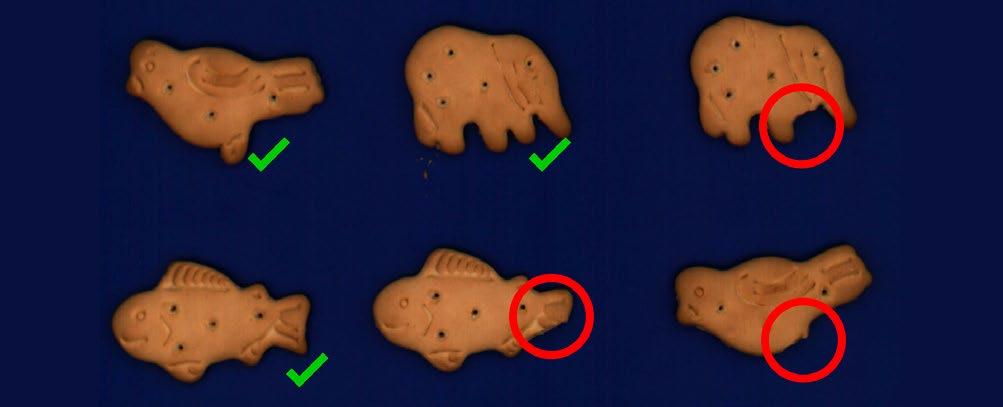


However, an AI-driven vision system can inspect 100% of products on the line and can instantly identify any issues with topping not being present, not being present in sufficient quantities, or not evenly distributed. The sophisticated AI is able to reliably detect and distinguish similarly colored ingredients like red peppers and tomato pieces by looking not just at the color of the ingredient but taking into account the shape, appearance, and texture of the ingredient. This is a significant improvement over traditional vision, which relies solely on color differences. Also, because the AI system constantly learns with each pizza inspected, this ingredient detection capability improves with time.
”With an AI vision system equipped with AI models to detect foreign materials on the product's surface, bakeries can implement a powerful application to inspect every product on the line for even the most challenging foreign materials.“
Andrew McGhie, Global Business Development Director of Vision Systems, KPM Analytics
It is nearly impossible for a human inspector to identify and correct an issue with the pepperoni applicator in a timely manner to minimize defective products reaching the packing area. The AI function of the pepperoni can not only identify an issue quickly, it can also communicate with the pepperoni slice applicator machine to change parameters to address the issue or, as a last resort, set off an alert or automatically redirect products that don’t have enough pepperoni slices to a re-work conveyor.
Well-trained AI vision systems can detect subtle anomalies and defects in specific baked goods, such as pieces broken off animal-shaped crackers or cookies.
A second developing use case for AI in baking processes is enhancing anomaly and defect detection. Take, for example, an animal cracker production line – each cracker has detailed features that identify it with a specific animal. Too many broken crackers that make it through the processing line and into the product packaging will reflect poorly on the brand.
However, with an AI vision system trained to inspect 100% of the biscuits or crackers leaving the oven or cooling zone, these shape recognition and defect detection capabilities can be very reliable and used to drive a rejection mechanism to remove defective products from the line. As a biscuit or cracker passes under the camera, the AI system first discerns what type of animal the animal cracker is supposed to be. It then determines if it is missing any features and to what
degree. If an elephant is missing its trunk or a bird is missing its beak, the AI system can make that determination faster and more consistently than an average product inspector. The baker also has the ability to determine and set as a rejection criterion how bad the defect needs to be before the biscuit is rejected.
Then, a third core use case – and one that is critically important to baking companies – is AI inspection’s ability to enhance foreign material detection efforts. Foreign material can be something as simple as a dark spot (carbon, dirt, or grease) or light spot (excessive flour, unbaked dough, etc.) or a true foreign material such as part of a blue rubber glove, a broken bit of belt, or blue plastic from the wrapping of a shortening block. Each product recall due to harmful materials finding their way onto the product or in the packaging can severely impact a bakery financially and create an uphill battle to regain consumer trust. X-ray systems do an excellent job of detecting dense objects but are less effective against objects like paper, plastic, films, and other equally harmful objects that can be difficult to see.
However, with an AI vision system equipped with AI models to detect foreign materials on the product's surface, bakeries can implement a powerful application to inspect every product on the line for even the most challenging foreign materials. It is also common for the bottom of the product to be inspected as well as the top, increasing the likelihood of any contaminant on the surface of the product being detected and then rejected from the product flow before the product is packaged and sent to the customer.
Another emerging foreign material detection method, hyperspectral imaging, provides further capability to detect objects on the product's surface by combining visible spectrum imaging technology with near-infrared (NIR) and up to short-wave infrared (SWIR). Hyperspectral imaging offers extra assurance by detecting foreign materials that manual observation can rarely identify.
Integrating AI-driven vision inspection systems is just the beginning, with future advancements likely to push the boundaries of automation, quality control, and production efficiency. Bakeries that embrace these technologies will enhance their operational capabilities, cope with an unstable workforce, and stay competitive in a market that increasingly demands precision and consistency. As AI becomes more sophisticated, we can expect the industry to move toward fully autonomous production lines, where minimal human intervention and product quality reach unprecedented levels. The future of baking lies in the seamless fusion of technology and tradition, paving the way for innovation and excellence in every bite. +++

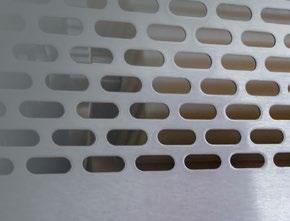


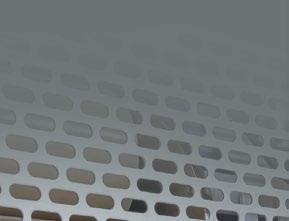
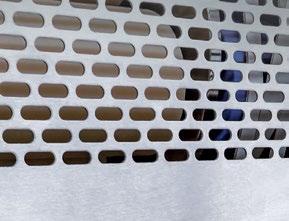
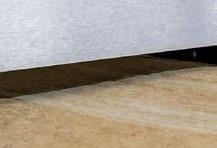


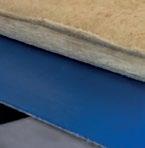












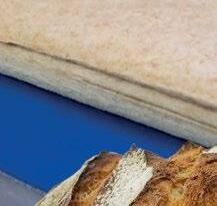
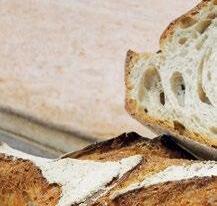
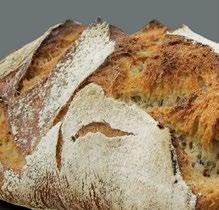


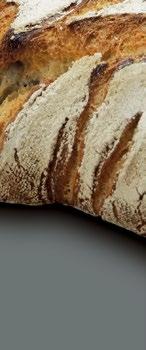










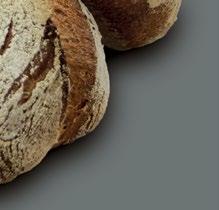



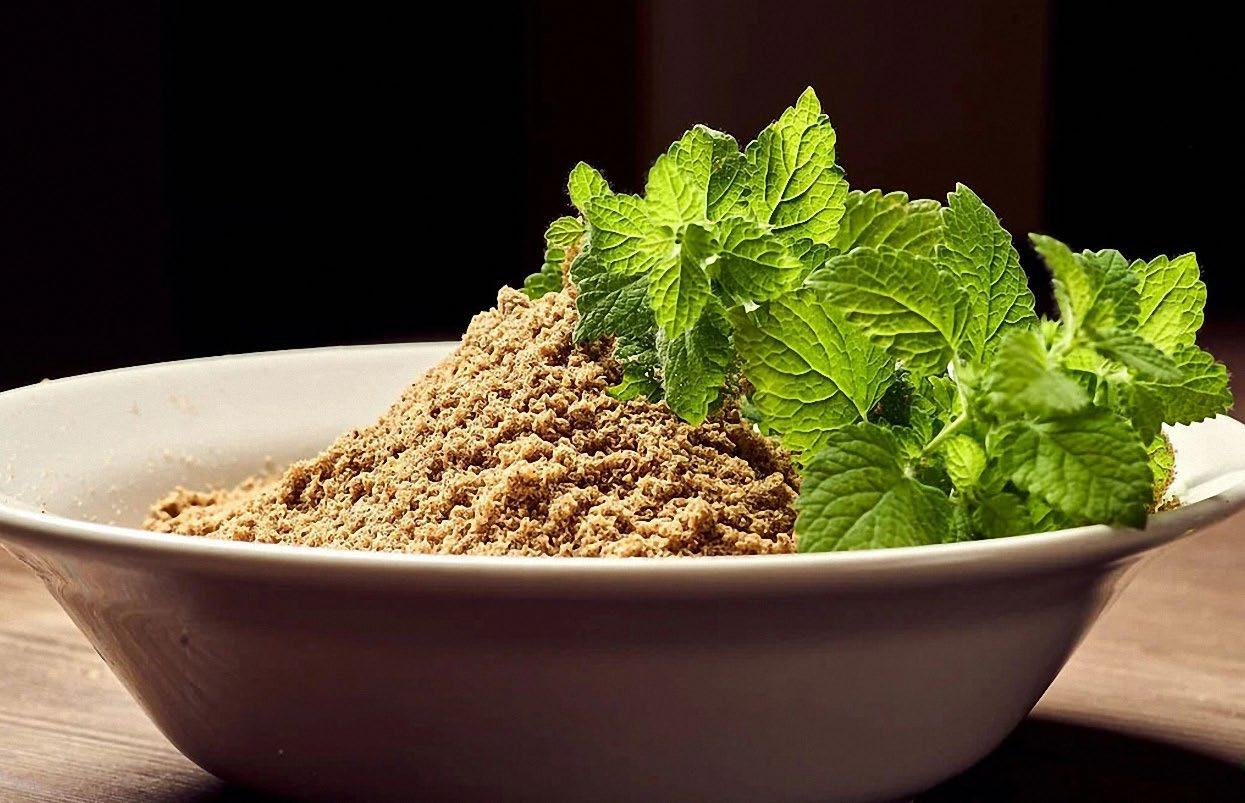
In a world where sustainability is becoming more than just a buzzword, the food industry is increasingly exploring innovative alternatives to traditional ingredients.
By Dimitris Argyriou, Managing Director, Grainar
+One of the most intriguing and promising of these alternatives is cricket flour, a protein-rich, environmentally friendly option that is slowly but surely gaining acceptance. This article delves into the rise of cricket flour, its benefits, the hurdles it faces, and its potential to become a staple in our diets.
Imagine a small town in the heart of Italy, where traditional cuisine reigns supreme. In Montecassiano, a company called Nutrinsect is challenging culinary norms. Led by Josè Francesco Cianni, Nutrinsect recently became the first company in Italy to receive approval for selling food products made from crickets for human consumption (pictured above). For Cianni, this isn't just a business milestone; it's a momentous step forward in the quest for sustainable food sources. “A new page in the history of food has been opened,” he declares, emphasizing the potential of cricket flour to transform our diets 1
The crux of the cricket
Why crickets, you might ask? The answer lies in the pressing challenges our world faces: climate change, biodiversity loss, population growth, and food security. Traditional livestock farming is resource-intensive and environmentally taxing. In contrast, crickets require significantly fewer
1 The Guardian, February 24, 2024
resources. For instance, producing one kilogram of crickets requires only 7 liters of water, compared to the staggering 3,500 liters needed for the same amount of beef.
+ Environmental impact
Cricket farming is a model of efficiency. It uses minimal land and water, and crickets emit far fewer greenhouse gases than cattle or pigs. Moreover, crickets can be farmed vertically, saving precious land space. This makes cricket flour an environmentally sustainable option that could significantly reduce the food industry’s carbon footprint.
+ Nutritional powerhouse
Beyond sustainability, cricket flour is a nutritional gem. It is packed with up to 70 % protein and contains all nine essential amino acids, making it an excellent protein source for vegetarians and vegans. Additionally, cricket flour is rich in B12, iron, calcium, and unsaturated fatty acids. These nutrients are often challenging to obtain in a plant-based diet, highlighting cricket flour's potential to enhance dietary health.
Cricket flour's versatility allows it to be used in various culinary applications. From baked goods to pasta, it can be seamlessly integrated to enhance the nutritional value of everyday foods.
“Despite the promising outlook, there are notable challenges and criticisms associated with cricket flour.”

+ Muffins with cricket flour
Studies have shown that substituting wheat flour with cricket powder in muffins can significantly enhance their protein content without compromising taste or texture. Muffins enriched with cricket powder have reduced carbohydrate content, increased protein, and improved texture, making them a healthier snack option.
+ High-protein pasta
Cricket flour can also be used in high-protein, gluten-free pasta. Such pasta not only provides a substantial protein boost, but also has a lower glycemic index, ensuring prolonged satiety and energy levels. The delicate and distinctive taste of cricket pasta is an added culinary advantage.
+ Bread making
Cricket flour can also be used in bread making. By incorporating cricket flour into traditional bread recipes, bakers can significantly boost the protein content and add essential nutrients like B12, iron, and calcium to their products. The addition of cricket flour can enhance the nutritional profile of bread without compromising its texture or flavor, making it a viable option for healthconscious consumers.
In early 2023, the European Union approved the sale of insects, including crickets, locusts, and darkling beetle larvae, for human consumption. This regulatory milestone paved the way for companies like Nutrinsect to enter the market with insect-based food products. The EU's stringent guidelines ensure these products are safe for consumption, produced under hygienic conditions, and clearly labeled. While the long-term health effects of consuming insects are still being studied, current evidence supports their safety for most people, except those allergic to shellfish, who might react to the chitin in insect exoskeletons.
The edible insect market in Europe is expected to grow significantly, reaching an estimated EUR 2.7 billion by
Dimitris Agryriou, Food Scientist, Managing Director, Grainar
2030. This growth is fueled by a combination of increased environmental awareness and recognition of the nutritional benefits of insects. Cricket farming also presents new economic opportunities, especially in regions where traditional agriculture is less viable.
Despite the promising outlook, there are notable challenges and criticisms associated with cricket flour. Firstly, the production costs for cricket flour are currently higher compared to traditional flours, which could make it less accessible to the average consumer. Additionally, there are cultural and psychological barriers to overcome.
The ‘yuck’ factor is a real issue; many consumers, myself included, find the idea of eating insects unappealing, regardless of how they are processed. From a nutritional standpoint, while cricket flour is a rich source of protein and other nutrients, it does not entirely replace the complex nutritional profile provided by a diverse diet. There is also a need for more long-term studies on the health effects of consuming insects regularly. Moreover, some people might be allergic to chitin, a component found in the exoskeleton of insects, which is similar to the allergen found in shellfish.
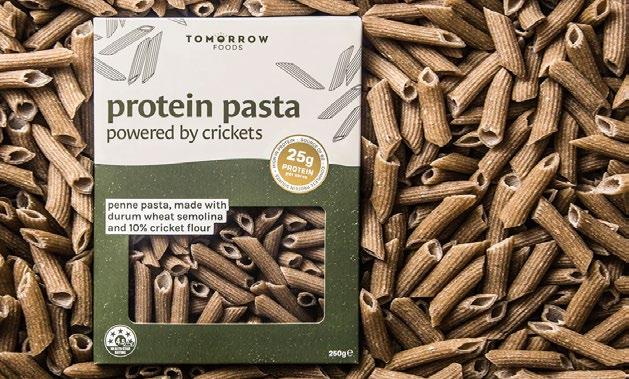
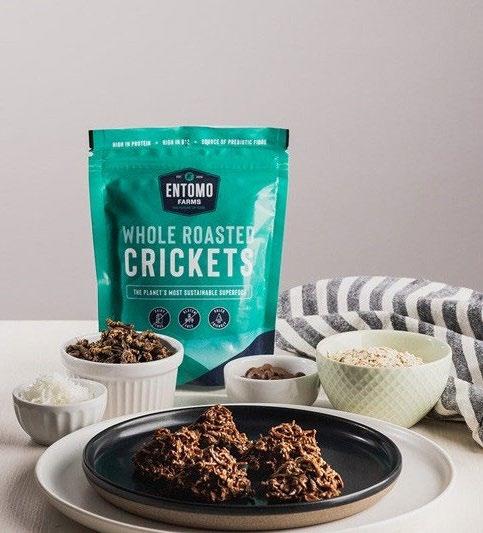
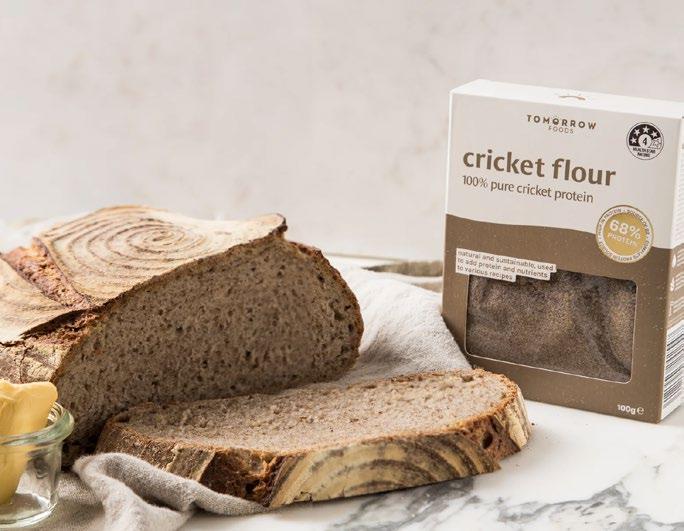
The rise of cricket flour represents more than just an addition to the pantry; it symbolizes a shift towards a more sustainable, nutritious, and environmentally friendly food system. As we face the challenges of feeding a growing global population and mitigating climate change, cricket flour offers a promising solution. It’s time to look beyond traditional food sources and embrace innovative alternatives that can lead us toward a healthier and more sustainable future.
“Beyond sustainability, cricket flour is a nutritional gem. It is packed with up to 70 % protein and contains all nine essential amino acids.”
Dimitris Argyriou, Managing Director, Grainar
However, it's essential to approach this with a balanced perspective. The potential of cricket flour is vast, but so are the challenges. Overcoming the cultural aversion to eating insects will not be easy. As a consumer and a writer, I find myself intrigued yet hesitant. The concept is sound, and the benefits are clear, but the psychological barrier remains significant.
Next time you bite into a muffin or twirl some pasta around your fork, consider the potential impact of cricket flour. This tiny insect could play a significant role in addressing some of our biggest global challenges. Embracing cricket flour might just be a small step for our diets, but a giant leap for sustainability and nutrition.
As a consumer and a writer, I find myself intrigued yet hesitant. The concept is sound, it clearly brings valuable benefits, but, for now, the psychological barrier remains significant. +++
References
1. Belluco, S., Losasso, C., Maggioletti, M., Alonzi, C. C., Paoletti, M. B., & Ricci, A. (2013). Edible insects in a food safety and nutritional perspective: A critical review. Comprehensive Reviews in Food Science and Food Safety, 12(3), 296–313.
2. Brogan, E. N., Park, Y. L., Matak, K. E., & Jaczynski, J. (2018). Characterization of protein in cricket (Acheta domesticus), locust (Locusta migratoria), and silkworm pupae (Bombyx mori) insect powders. LWT - Food Science and Technology, 152, 112314.
3. Cavalheiro, C. P., Ruiz-Capillas, C., Herrero, A. M., Pintado, T., & Silva, M. C. A. (2022). Cricket (Acheta domesticus) flour as meat replacer in frankfurters: Nutritional, technological, structural, and sensory characteristics. Innovative Food Science & Emerging Technologies, 83, 103245.
4. Cavalheiro, C. P., Ruiz-Capillas, C., Herrero, A. M., Pintado, T., Avelar de Sousa, C. C., Leite, J. S. F., & Silva, M. C. A. (2024). Potential of cricket (Acheta domesticus) flour as a lean meat replacer in the development of beef patties. Foods, 13, 286. https://doi.org/10.3390/foods13020286
5. Pauter, P., Różańska, M., Wiza, P., Dworczak, S., Grobelna, N., Sarbak, P., & Kowalczewski, P. Ł. (n.d.). Effects of the replacement of wheat flour with cricket powder on the characteristics of muffins. Institute of Food Technology of Plant Origin, Poznań University of Life Sciences, Wojska Polskiego 31, 60-624 Poznań, Poland.
6. Scholliers, J., Steen, L., & Fraeye, I. (2020). Partial replacement of meat by superworm (Zophobas morio larvae) in cooked sausages: Effect of heating temperature and insect: Meat ratio on structure and physical stability. Innovative Food Science & Emerging Technologies, 66, 102535. [CrossRef]
7. van Huis, A. (2013). Potential of insects as food and feed in assuring food security. Annual Review of Entomology, 58, 563–583. https://doi.org/10.1146/annurev-ento-120811-153704
8. Zhang, F., Cao, C., Kong, B., Sun, F., Shen, X., Yao, X., & Liu, Q. (2022). Pre-dried mealworm larvae flour could partially replace lean meat in frankfurters: Effect of predrying methods and replacement ratios. Meat Science, 188, 108802.




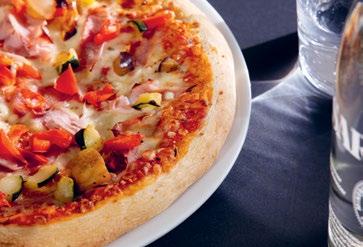

Many consumers tend to scrutinize nutritional labels when buying bakery products, with an inclination towards prioritizing avoidance and moderation, rather than focusing on positive nutrition.
By Kate Kehoe, Marketing Executive at FMCG Gurus
+On a global scale, a significant majority of consumers consistently review the nutritional information on bread products, with 64% stating that they check this most of the time/all of the time. Their primary focus lies on scrutinizing the levels of sugar, additives, and ingredients when examining these labels. Following the pandemic, heightened health consciousness is expected to prompt consumers to prioritize products with fewer ingredients, associating simplicity with freshness, naturalness, and better health. Clarity and simplicity in ingredient listings are crucial as consumers tend to prefer straightforward information and may be cautious of intricate components, including preservatives, additives, and health-related assertions. This shift underscores the importance of transparent and easily comprehensible labeling practices to meet the evolving expectations and concerns of health-conscious consumers.
Consumers find functional claims in the bakery sector appealing and seek ingredients that provide a health advantage beyond fundamental nutrition. Consumers exhibit a keen interest in food items incorporating functional ingredients, providing a health-enhancing advantage. Claims related to high fiber and protein content, known to
promote digestive wellness, are particularly sought-after in diverse bakery segments. For instance, 58 % of global consumers state that they find bakery products high in fiber appealing, followed by 56 % who deem high in protein claims appealing.
”58 % of global consumers state that they find bakery products high in fiber appealing, followed by 56 % who deem high in protein claims appealing.“
Kate
Kehoe, Marketing Manager, FMCG Gurus
Additionally, sustainable ingredient claims resonate with consumers as they assure ethical sourcing practices within bakery products. For example, 56 % of global consumers state that they find sustainably sourced ingredients claims appealing. The inclusion of whole grains and ancient grains, rich in functional elements like fiber, often positions them as healthier alternatives to white bread. These attributes make products appealing to consumers seeking improved nutritional profiles, aligning with their preference for betterfor-you options that prioritize health and wellness benefits.
Ingredients play a pivotal role in shaping quality perceptions in the bakery industry, with consumers seeking authenticity and traceability. Globally, consumer priorities are tied in with product quality and flavor, with an emphasis on equating more premium products with superior taste and the incorporation of natural ingredients.
Preferences are shaped by perceptions of taste authenticity and the integrity of product components, highlighting preferences for chemical-free formulations (69 %) and high-quality ingredients (69 %). Moreover, the source or origin of the product holds significance for consumers when gauging the premium status of bakery offerings, further underlining the importance placed on product quality and provenance in consumer decision-making processes.
Consumers are inclined to steer clear of sugar, often labeled as a dietary evil, while prioritizing genuine and authentic ingredients. Claims of naturalness appeal to 68 % of consumers, which encompasses fewer ingredients, additives,
and preservatives. Of these, sugar-free claims gained the highest appeal, closely followed by non-genetically modified and general natural claims.
Natural attributes are linked to perceived benefits for both consumers and the environment, as they signify the absence of chemicals and potential health advantages.
Notably, the negative perception of sugar, associated with health issues like weight gain and diabetes, motivates consumers to seek moderation and reduction of its intake. In this context, more than a third of consumers also express interest in free from claims, emphasizing the significance of clean-label and better-for-you claims in bakery products. These inclinations underscore consumer preferences for products aligned with their health and wellness goals, further strengthening the appeal of better-for-you bakery offerings. +++
This article is based on FMCG Gurus: Fresh Bakery Survey 2023. For more information, contact FMCG Gurus at info@fmcggurus.com.
















BREAD INITIATIVE
The biggest organizations in the industry joined their efforts to formulate a shared vision regarding the essential role of bread production in Europe, for Europe. The message coming from all voices is clear and simple: bread is best.
+AIBI, CEBP, COFALEC, European Flour Millers and Fedima developed a project aimed at promoting the enduring qualities of bread. Within the project called ‘Bread Initiative’, several campaigns have been carried out to support bread’s image and production, as a basic, nutritious and great-tasting foodstuff.
Within this project, the five member associations recently drew together a vision paper representing their collective stance on bread and its significance for consumers and for the baking industry, titled ‘Keeping Bread on the Table’. The document advocates for key policies that can safeguard bread security, for regulatory support for bakeries, and help in the industry’s sustainability efforts, in the new European Parliament term (2024 – 2029).
Several measures could ensure supply chain security, as long as bread production is considered a strategic priority sector, the document argues. Actions should include “investing in domestic, high-quality wheat production, prioritizing the EU agricultural raw material supply for the food sector and developing an EU long-term vision of food security that includes bread,” the vision paper details.
The organizations signing the document advocate for “Upholding ‘Better Regulation’ as a cornerstone of the EU regulatory process, rooted in its core principles.” For this, drastically cutting red tape is recommended, as a critical measure, especially for small bakeries. The industry associations lobby the European Parliament’s new members to favor simpler regulations, streamline paperwork and
The ‘Bread Initiative’ project has a dedicated platform with resources about and by its member associations. The latest activity in this coordinated effort is the release of the vision paper. www.bread-initiative.eu
reporting, as well as straightforward, consistent rules, to establish a business-friendly environment for the bakery industry. In the same direction, excessive regulations should be avoided, the paper underlines.
The authors stress the importance of science-backed evidence in making any regulatory decisions.
‘Better regulations’ should also include mitigating risks and unintended consequences faced by the bakery sector as a result of new regulations, such as those intended for agriculture. At the same time, the Bread Initiative is committed to driving sustainability in the industry and supporting bakery businesses in their transition process.
EU funding has been allocated to various activities throughout the supply chain, with an influence on grains and bread-making policies, too. A budget of EUR 186 million was set by the EC in 2022 to fund promotion activities for EU agri-food products, for example. Dedicated bread promotion campaigns were organized in Belgium, the Netherlands, Sweden and Spain – and the messages and relevant resources were shared within the network established by this multi-team project. +++

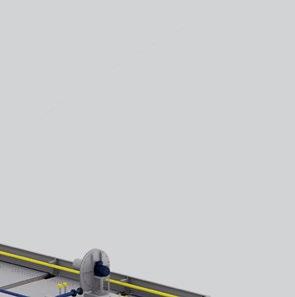









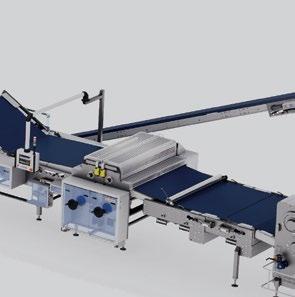
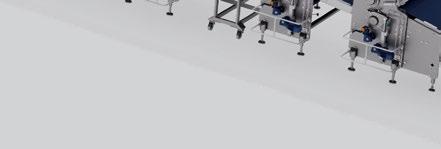
























Reading Bakery Systems (RBS) introduced a new, 90-degree laminator for cracker production. The new design offers a smaller footprint, greater flexibility, and easier sanitation and maintenance, RBS says. The dough can be precisely and automatically controlled, regarding the sheet length, number of laminations and conveying speed, for improved process consistency.
The laminator also features an optional bypass, so that both laminated and non-laminated crackers can be produced on the same line. “The dough sheeter may be installed to the side or directly above the laminator for a compact and efficient production layout,” RBS recommends. The laminator can be set up in several different configurations, depending on product ranges and the space available.
The Koenig Group introduced a new dough sheeting line, the Artisan SFE EC, with improvements in process efficiency, cleanability and user-friendliness. The machine will be presented at südback, in October. Production is carried out without creating an edge section of dough, which means that there is no scrap. It has a wide range of stamping tools and integrated inline seeding. For more product diversity, a cup rounding station can also be integrated into the new sheeting line. It is a compact dough sheeting line that offers several advantages, processing doughs with a dough yield of 155 to 175 – from grain roll doughs to soft doughs.
The ‘E’ in its name stands for efficiency in bread roll production via endless dough sheet generation, which is supported by an ergonomic design. “The main focus during the development of the system was clear: technology that supports the commercial baker in their daily bread roll production,” Koenig explains in the launch announcement. +++


“The new 90-degree laminator is a more compact design, ideal for plants with limited space between process lines. Its open frame construction simplifies routine sanitation and maintenance,” said Cameron Johnston, Senior Director of Innovation at RBS. +++
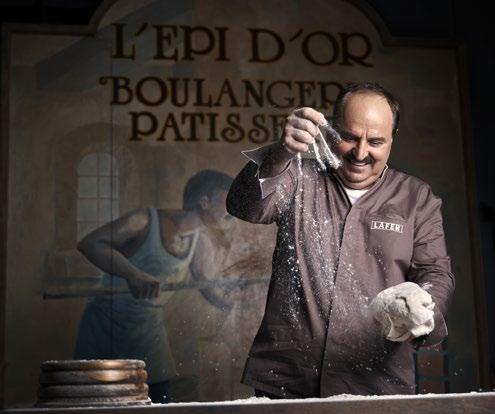
Bridor developed several new recipes with renowned top chef Johann Lafer. The first results of this partnership will be presented at the Bridor stand at Alles für den Gast, held in Salzburg from November 9 to 13. Visitors will have the opportunity to meet Johann Lafer in person and discover his new creations. Bridor created several short videos with Johann Lafer: In the video ‘Quick & Delicious’, Johann Lafer answers ‘This or That’ questions about French, German and Austrian snacks, for example. In the video titled ‘Salmon on Bun’n’Roll’, Lafer shows together with Jean-Luc Kasper how to prepare a delicious salmon recipe on the trendy bun’n’roll.
Bridor has been working with Lafer on new product development for many years. Together with Jean-Luc Kasper, master baker and pastry chef at Bridor, he worked on refining Bridor’s basic products and develop inspiring recipes. +++
Title: Sustainability touchstone (Prüfstein Nachhaltigkeit)
Publication: 2024
Language: German 200 pages , 49 €*

Price including VAT, for printed and digital copies. Shipping costs are not included.

La Lorraine Bakery Group officially launched a new soft bun line into production, at its headquarters in Ninove. The bakery site specializes in soft buns and rolls for retail and foodservice. With this investment, extra capacity was created at the facility, and new process features were added, including bun slicing and sprinkling. The expansion also creates new jobs for the company, which is an established big employer in East Flanders. The LLBG Executive Committee, the mayor of Ninove, city representatives, and members of the press attended the ribbon-cutting event, joining La Lorraine’s team. +++
Fedima published its latest activity report for 2023-2024, highlighting its community work and latest projects. For the past year, the organization’s Technical Committee carried out work on labeling in an effort to find a common approach to Precautionary Allergen Labelling (PAL). In addition, Fedima’s Enzyme Expert Group created documentation on the benefits of enzymes in the bakery industry, in collaboration with AMFEP. The topic of contaminants was also on the agenda, as the past year has seen highly anticipated developments in mineral oils, including the regulatory follow-up on mineral oils’ maximum levels. This year, Fedima also continues to endorse its ‘Understanding Sourdough’ paper. Fedima’s Sustainability Committee focused its work on responsible sourcing, promoting its Code of Conduct for Responsible Sourcing in-house. +++



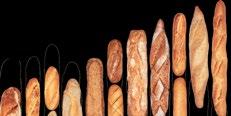
baking+biscuit international is published six times a year.
Single copies may be purchased for EUR 15. Subscription rates are EUR 75 per annum. Students (with valid certification of student status): EUR 40. (All rates include postage and handling, but not VAT).
Cancellation of subscription must be presented three months prior to the end of the subscription period in writing to the publishing company. Address subscriptions to the above stated distribution department.
Claims will not be accepted for any copies not received or lost copies due to reasons being outside the responsibility of the publishing company. This magazine, including all articles and illustrations, is copyright protected. Any utilization beyond the tight limit set by the copyright act is subject to the publisher’s approval.
Online dispute resolution in accordance with Article 14 Para. 1 of the ODR-VO (European Online Dispute Resolution Regulation): The European Commission provides a platform for Online Dispute Resolution (OS), which you can find at http://ec.europa.eu/consumers/odr
Valid advertising price list: 2024
PUBLISHING HOUSE
Food2Multimedia GmbH Schoolkoppel 27 21449 Radbruch, Germany +49 4178 244 9797 www.foodmultimedia.de
EDITOR EMERITUS
Hildegard M. Keil hildegard_keil@t-online.de
PUBLISHER
James Dirk Dixon dixon@foodmultimedia.de
EDITOR-IN-CHIEF
Catalina Mihu mihu@foodmultimedia.de
EDITOR
Helga Baumfalk baumfalk@foodmultimedia.de
COPY EDITOR
Annie Dixon annie.dixon@foodmultimedia.de
SUBSCRIPTIONS Viktoria Usanova usanova@foodmultimedia.de DISTRIBUTION vertrieb@foodmultimedia.de
ADVERTISING Dirk Dixon dixon@foodmultimedia.de
SOCIAL MEDIA
Annie Dixon annie.dixon@foodmultimedia.de
LAYOUT/GRAPHIC
LANDMAGD Design aus der Heide
Linda Langhagen, design@landmagd.de PRINT
Leinebergland Druck GmbH & Co. KG Industriestr. 2a, 31061 Alfeld (Leine),

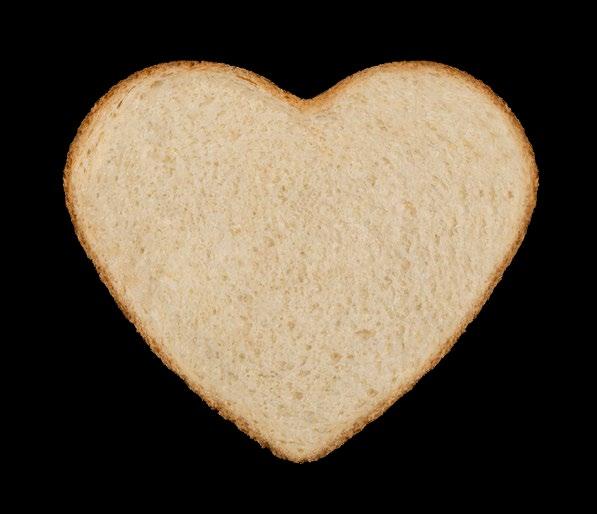


The future of baking lies in sustainability. While bread production is increasing worldwide, waste is also causing serious problems. Millions of tonnes of food, including bread, are wasted, with huge impact on the environment. Think of the CO2 emissions, water consumption and energy lost with every unnecessarily discarded slice. Repeatloaf offers the solution. With a circular approach, recycling bread scraps into new, high-quality bread, we help bakers worldwide reduce their waste and lower their carbon footprint.
Visit us at Südback in Stuttgart from 26 to 29 October and find out how you can contribute to a sustainable future with Repeatloaf. Time for action, time for change. Because wasting bread? That has no place in the world of tomorrow.
Verhoeven Bakery Equipment Family has a long and successful history of tailor-made development, engineering and production for the food industry. In the bakery market the family labels have established a strong position due to innovative and creative turnkey solutions. We sell high-end production lines and state-of-the-art machines. Developed and made by a wonderful team of dedicated people. This makes us proud. We would love to show you why.









